72 Unmissable Things to Do in Tbilisi | A Local’s Guide
Georgia’s capital, Tbilisi, is a fascinating city to explore. It offers ancient architecture mixed with Soviet and modern buildings, distinctive cuisine, exciting museums and galleries, quirky attractions, and vibrant cafes and restaurants. This detailed local’s guide to the best things to do in Tbilisi combines touristy and less-known spots.

Tbilisi is my hometown. I was born and raised here, spent almost my entire life (except for the four years I did my Bachelor’s in Prague, Czech Republic), and currently live here.
Growing up, I took the city for granted and believed there were few Tbilisi attractions to keep a traveler interested. I would get the appeal of Georgia for its beautiful mountainous landscape, charming villages, cities, and ski resorts, but I rarely understood why people spend so much time in Tbilisi until I became a travel content creator and started looking at my hometown from a different angle.
Now, thanks to my work and the content I create, I have fallen in love with the city all over again. Today, it fascinates me at every corner and turn. I am always looking for new spots I didn’t know existed and feel absolutely joyous when I notice a detail on a building I haven’t seen before, even though I have walked past it hundreds of times.

However, I always say that to feel the Georgian spirit and understand its heritage, customs, and traditions, don’t limit your time only to Tbilisi and add a few of the country’s beautiful places to your itinerary.
It took me years to explore Tbilisi as a local, pretending to be a tourist to get to know it like the back of my hand. This detailed guide is the result of my continued research and is updated regularly, so you won’t need to search elsewhere for what to see in Tbilisi—everything you require is right here!
The guide to unmissable things to do in Tbilisi is divided into seven sections. It includes the best places in Tbilisi old town and the experiences to have, other popular offerings in the city center, local spots and alternatives to the touristy sites, a few iconic Soviet sightseeing, food-related activities, nightlife outings, and several options for the best hikes and day trips.
My Travel Essentials
Get an eVisa: Check if you need one at iVisa and fill out the form to get your eVisa easily.
Book a flight: I use Skyscanner or WayAway. The latter offers cashback with a Plus membership.
Airport transfers: Avoid the hassle of public transport and pre-book a transfer with Gotrip.
Reserve a hotel: My go-to platform for hotels or apartments is Booking.com.
Wine tours: Eat This! Tours offer premium wine tours. Use code RFD5 to get 5% OFF.
Hiking & culture tours: WT Georgia is the best for unique trips. Email them Red Fedora & get 10% OFF.
Find best-suited tours: For other tours, entrance tickets, and activities, I use Viator or Get Your Guide.
Rent a car: With affordable prices, Local Rent is one of the best car rental platforms.
Hire a driver: GoTrip is ideal for long-distance private transfers at very reasonable prices.
Debit card: I have Wise (an alternative to Revolut) for local money withdrawals without hidden fees or high exchange rates.
eSIM: To avoid heavy roaming fees, use Airalo or Saily. Compare prices and GB packages. Use BAIA2592 on Airalo and BAIAIR6152 on Saily to get 3 USD on both.
Travel insurance: SafetyWing covers health insurance and has add-ons for adventure sports and electronics theft coverage.
Disclaimer
This post includes affiliate links to products, which earn me a small commission at no extra cost to you. This helps to fund my blog and bring more authentic articles to you 🙂 Learn more
Why is it worth planning a trip to Tbilisi?
Lodged at the crossroads of Europe and Asia, Georgia has long been a highly contested country, coveted by various foreign empires and powers that have ever existed over the centuries. This ongoing history of conquest and control has been woven deep into Tbilisi’s streets, architecture, and culture.

Its origins date back to the 5th century when King Vakhtang I Gorgasali of Iberia founded the city, drawn to its sulfur-rich hot springs and named it “Tbilisi,” meaning “warm place.” These sulfur baths are still operating today and are a famous spot for locals and visitors. Find more information below.
Initially, Georgia’s capital was Mtskheta, but King Dachi, Gorgasali’s successor, relocated it to Tbilisi due to its strategic position along the silk and other trade routes. This boosted its prosperity while making it vulnerable.
By the 6th century, Tbilisi fell under Persian rule, beginning a long sequence of foreign dominations. Over the centuries, Tbilisi has been ruled by the Byzantines, Arabs, Seljuk Turks, Mongols, Persians, and Russians.

Until the 1990s, Georgia’s independence came briefly twice. First, from the 12th to 13th centuries, a period celebrated as the Georgian Golden Age, during which Tbilisi and the country thrived as a cultural and literary hub of the ancient world. And from 1918 to 1921, the Republic of Georgia was established after the Russian Revolution of 1917, which led to the Empire’s dissolution.
In 1921, we were absorbed into the Soviet Union, a chapter that would last until its collapse in 1991. Tbilisi’s streets, with their Soviet-era brutalist buildings scattered throughout the city, tell this layered story, too.
The transition from Soviet rule in the 1990s, often remembered as the “dark 90s” among locals (pretty much my entire childhood), was a time of hardship and instability with civil wars, no jobs, and a shortage of food and basic infrastructure. Slowly, Georgia and Tbilisi began rebuilding (it hasn’t finished even today), reclaiming its identity as a cultural capital of the Caucasus and shaping it into a dynamic and eclectic country.
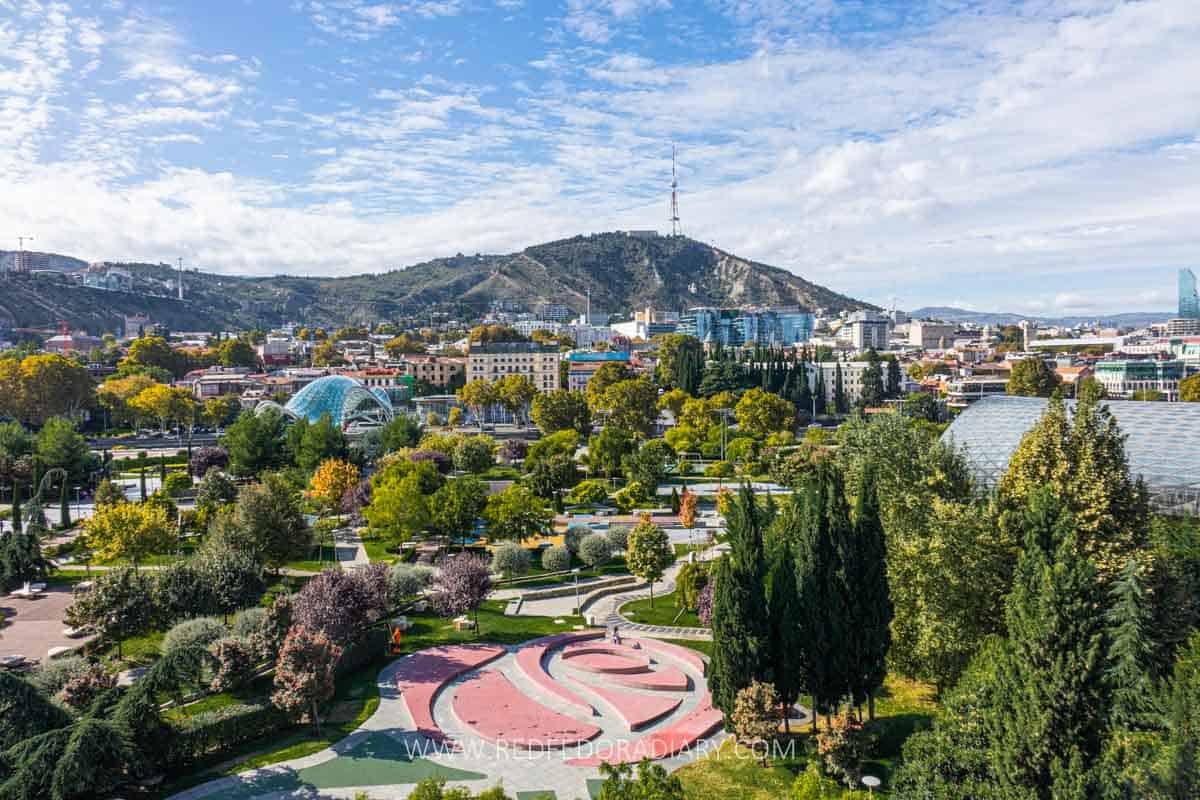
Today, Tbilisi proudly wears its history. Its narrow lanes reflect the city’s complicated history and the influence of the ruling empires of the past, still present around old neighborhoods of Abanotubani (old town), Sololaki, or Chughureti. It’s a city with old, new, and still unfolding stories woven into every corner, a place of hidden gems and spots.
Even though Georgia’s capital is a relatively small city, a list of Tbilisi sightseeing can be pretty long, and this 15,000-word ultimate guide proves it.
While it might not be the hidden gem in Europe anymore due to the low-cost airlines and one-year visa on arrival for 95 nations (check iVisa if you need one), Tbilisi still holds its charm, which has kept many of my foreign friends staying here for unplanned weeks, months, and even years. Read my post on what it is like living in Tbilisi as an expat and digital nomad.

Depending on where you come from, Tbilisi (and Georgia) can still be a budget destination with relatively low prices on public transportation, museum tickets, a bottle of wine, and full-course restaurant meals, to name a few.
Tbilisi is a flexible city that can be as expensive or as cheap as you want it to be. With plenty of free things to do, you can spend your budget on more authentic and fun experiences.
Basic Tbilisi travel tips
When planning your trip to Tbilisi for the first time, it’s essential to understand a few things, mainly how many days you need, when the best time is, how to get here, or where to stay.
Tbilisi things to do with a map
For a more comfortable way of exploring the city, here is the Google Maps list of all the things to do in Tbilisi that you can save and use whenever you need it. If you download the area for offline use, you will not need the data to access the spots
Top things to do in Tbilisi old town
If you’re wondering what to see in Tbilisi, the best area to start exploring is the gorgeous Old Town.
It is a lively maze of narrow streets with steep climbs and staircases that lead to incredible city views, restored colorful houses, weathered facades with rusty spiral staircases that add character to every corner, a mix of historic and modern charm and picturesque yet crumbling Tbilisi courtyards adorned with vines overtaking the balconies and wires.

In ancient times, Tbilisi was a walled city. The areas beyond were forested, including the current Freedom/Liberty Square. The town was burned down at least 30 times during various invasions and rebuilt repeatedly, so its authenticity has been lost to time.
The exact borderline of the Old Town is vague and is interpreted by many locals differently. For me, it encompasses the Abanotubani with Narikala Fortress and Mother of Georgia statue, Betlemi Quarter, Tabori Mountain, Metekhi Church with surrounding Europe Square and Rike Park, and various streets leading up and around Gudiashvili Square. For many, Sololaki is also part of Old Town, but technically, it’s beyond the city wall and part of the new development of the late 19th century.
Below is my personally curated list of the best places to visit in Tbilisi Old Town. The list is designed to showcase the city’s top attractions without missing a single highlight. It is in no particular order, so use it as your base.
Walk through Abanotubani
The historical area used to be the heart of Tbilisi’s hustle and bustle; after all, it is the birthplace of the city. According to the legend, this is where King Vakhtang Gorgasali hunted and discovered the hot sulfuring waters after his falcon and the prey pheasant were found boiled floating in the waters. This fascination led to the creation of the city he named Tbilisi, where the word ‘tbili’ in Georgian means’ warm’.
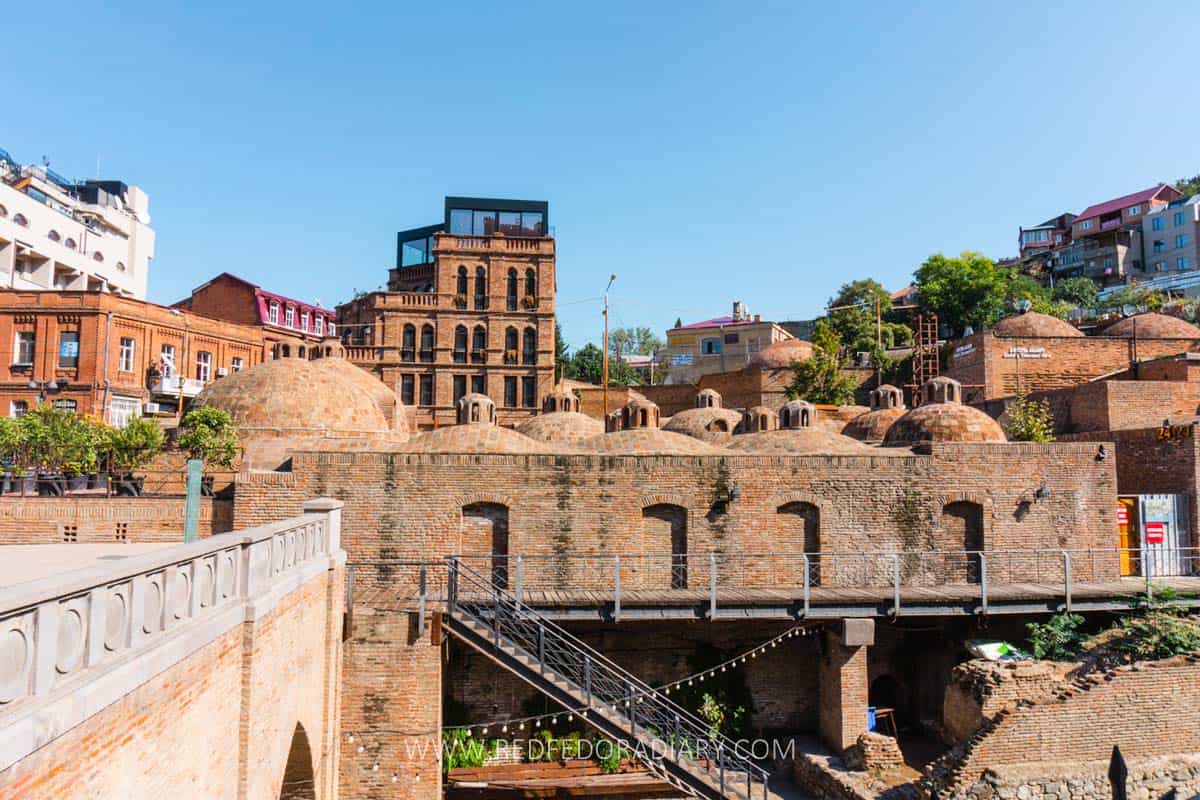
Abanotubani, or the ‘bath district’ in English, is a must-visit in Tbilisi and is often the first place to start the exploration. The picture-perfect brick domes with a mosque-like Chreli Abano, or ‘colorful baths,’ also known as Orbeliani Bath, are one of the famous shots you might have seen on various websites and marketing promotions.
Based on 13th-century historical sources, Tbilisi had 65 sulfur baths that impressed travelers passing through the city. Most current baths were created in the 17th and 18th centuries, influenced by Persian architecture.


These baths were not only used for healing purposes – people would spend an entire day here, resting, taking baths, and even dining. Mother-in-laws even checked the beauty and body of their future daughter-in-laws.
Past the Chreli Abano, follow the pathway through the Leghvakhevi, leading to the 22-meter-tall waterfall. Fig trees once covered the area, giving it the name, where ‘leghvi’ is a fig and ‘khevi’ means a gorge in Georgian.

Part of the gorge is on the Botanical Garden’s territory, and part is Abanotubani. The mountain river Tsavkisis Tskali flows here and eventually merges with the Mtkvari River.
During summer, the waterfall is calm and peaceful; in spring, it’s more voluminous, while in winter, it might even freeze.
2024 autumn update: Leghvtakhevi is partly closed due to construction at Narikala fortress.
Soak up in sulfur baths
An absolute must-do experience you shouldn’t miss here is a visit to the bathhouse, as no trip to Tbilisi is complete without it. Sulfur baths are believed to benefit your skin and the body’s general well-being. However, it may not be for everyone – the water is scorching hot, the air could be very warm, similar to a sauna, it smells funny, and the kisa scrub can be intimidating for some.


There are around 10ish bathhouses today, offering a choice of public (with separate male and female sections) and private rooms. Each bathhouse has a different price package, from 10-15 GEL for the public to 80-100 GEL per hour for private rooms. A thorough scrub known as kisa is an additional 20 GEL. It’s a nice massage to wash off the dead skin, after which the skin feels soft, silky, and smooth.
I typically book private rooms with my girlfriends at Chreli Abano or Gulo’s Thermal Bath, which costs 150 GEL per hour for the three of us. We always book the kisa scrub.
See the remains of the oldest sulfur bath in Tbilisi
While almost everyone thinks that these brick-domed sulfur baths dominating the Abanotubani are the prime example of Tbilisi’s historic bath district, the area actually hides even older sulfur bath that almost every traveler and local misses out on seeing.

Under the Forty Martyrs of Sebastian Monastery, you’ll find Tbilisi’s Antique Archaeological Museum, which contains impressive historical records that debunk the whole legend of Tbilisi’s foundation.
At the beginning of the 2010s, the monastery was rebuilt on the grounds of the former Middle Ages church. During the foundation excavations, a very important layer of ancient Tbilisi was revealed.

Besides the remains of the 13th-century wall that came down from Narikala Fortress, part of the 4th-5th century main Tbilisi wall, burials dating back before the Christianity, stone floor of the palace of Emirs of Tbilisi (8th to 11th century), ethnographic and daily items dating to various times, this museum hides Tbilisi’s first sulfur bath.
The bath, dating to the 2nd-3rd century, is not thoroughly researched and studied; whatever you see is most likely half of it. Stylistically, this bath combines Middle Eastern and Roman styles and elements.

This significant discovery shows that this area existed as a settlement way before Vakhtang Gorgasali “found” Tbilisi during his hunting sessions, around 500 years earlier when he decided to build the city and then move the country’s capital to the newly established Tbilisi, which was actually fulfilled by Vakhtang’s son Dachi.
The bath area distinctly shows the trace of a clay pipe that would bring in hot water to fill the baths. The columns are not original and were places to hold the church construction.
- Opening hours: Tue-Sun 10 am to 6 pm; Closed on Mondays.
- Entrance fee: 3 GEL, bring cash.
Explore the secret tunnel beneath sulfur baths
Once you reach the viewpoint of Chreli Abano and the Legvtakhevi, you’ll notice paths that lead to various other sulfur baths and rejoin at the bridge towards the Leghvbatkhevi.
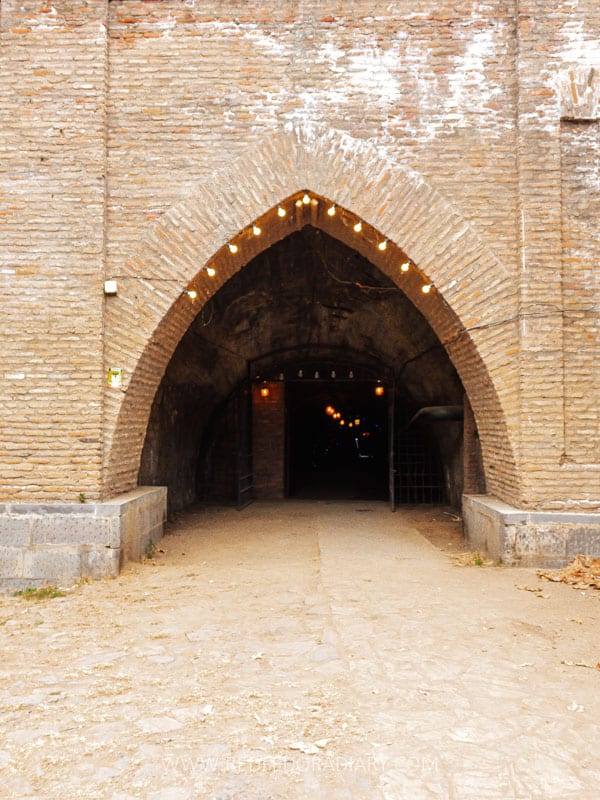

Follow the staircase down to the actual river stream. Turn to the right to face the arch and the construction from which you just walked down.
The massive gate is the entrance to the tunnel, which is free to enter and displays info boards of various important rulers and kings of Georgia, archival photos in black and white showing what Tbilisi looked like centuries ago, a few archeological finds such as old coins of various eras, and a photo exhibition before leading to one of the docks at Mtkvari River.
While nothing special in particular, walking through this tunnel evokes how citizens and merchants once entered Tbilisi.
Hike up or take the cable car to Narikala Fortress
2024 autumn update: Narikala Fortress is closed for renovation until 2025 (opening date to be confirmed), so you can’t go inside, but the cable car works, taking you to the Mother of Georgia statue (next section).
Overlooking the historic area, the Narikala Fortress is one of the city’s most iconic landmarks and the oldest castle, dating back to King Gorgasali’s reign. Throughout its existence, the fortress has always been ruled and captured by various foreign powers who wanted domination over Georgia.

The citadel’s current name comes from the 13th-century Mongol invasions, and it was renamed ‘Narin Qala,’ meaning ‘small fortress.’ Most of its current forts date back to the 16th and 17th centuries. Sadly, a strong earthquake destroyed and damaged a significant part of the fortress in 1827.
Narikala was a defensive castle with a complex system fortified with solid walls, towers, and bastions. It was challenging to reach and overtake. Until the 17th century, the inner territory of Narikala was home to the King’s Palace.
After Georgia was annexed into the Empire of Russia in 1801, the fortress lost its importance. It became a storage unit for the Russian army’s ammunition and medicine.
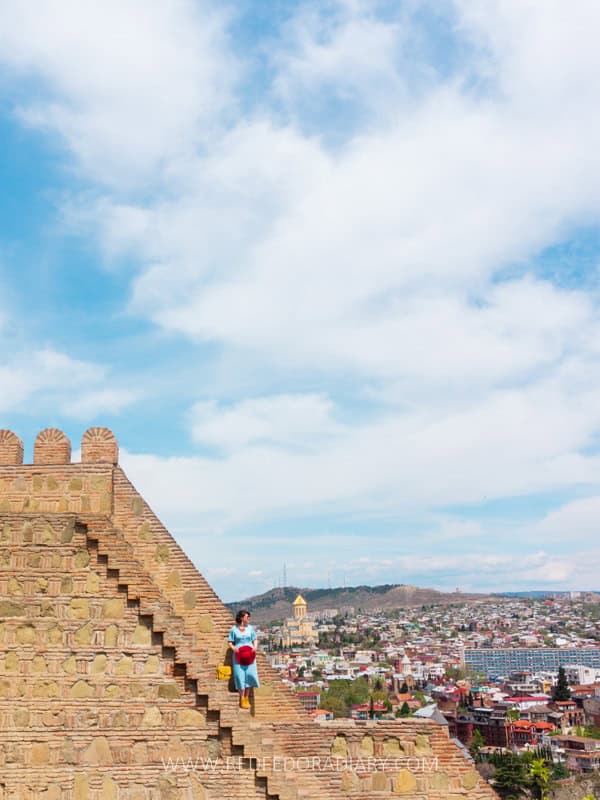
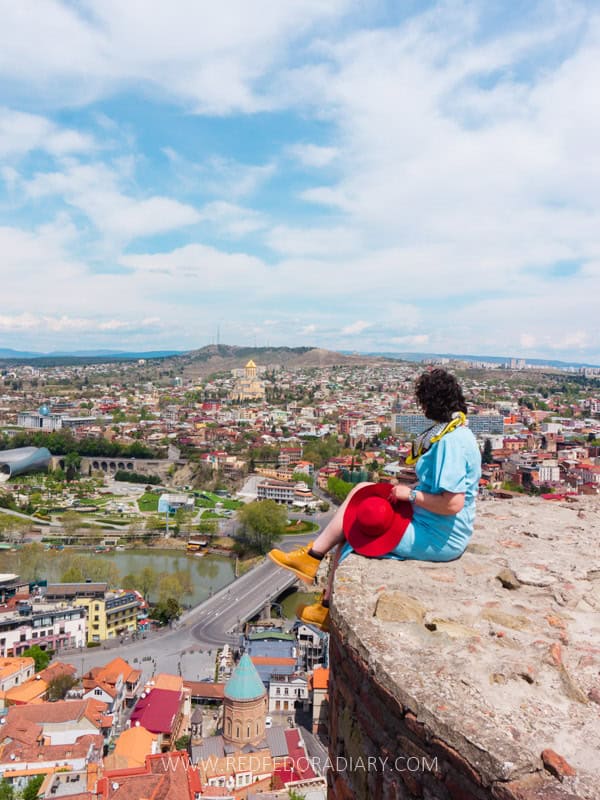
While you can walk up the steep cobblestone hill from Gorgasali (Meidan) square, my preferred way is to take the cable car from Rike Park and then walk my way down.
The gorgeous views over the sulfur domes, orange rooftops, and Rike Park, with the Avlabari neighborhood in the background, make it one of Tbilisi’s incredible viewpoints.
Interesting fact: In 1848, lightning hit one of the units in Narikala Fortress, where the Russian army stored its gunpowder. This resulted in a massive explosion that threw rocks all the way to the territory of the current Holy Trinity Cathedral in Avlabari.
Meet the Mother of Georgia
Right next to Narikala Fortress, towering over the city, stands a massive, 20-meter-tall figure of a woman holding a bowl and a sword. That’s the Mother of Georgia, or Kartlis Deda, a symbol of Georgian hospitality and strength.
The bowl in her right hand is for those who come as friends to Georgia, offering a glass of wine, while the sword in her left hand shows the readiness to defend against those who come as enemies.

Placed here in 1958 to commemorate Tbilisi’s 1500th anniversary, the original statue was made out of wood by Elguja Amashukeli, the prominent Georgian sculptor who also created many exciting structures in Tbilisi and across the country. The statue’s original name is ‘Dedaqalaqi’ or ‘the capital’ in English, but locals started calling it Kartlis Deda.
It was intended to decorate the capital temporarily, but Georgians loved it so much that the authorities decided to make it permanent. In 1963, Amashukeli covered it with aluminum for protection purposes. In 1997, the old Kartlis Deda was replaced with the current one, also made by Amashukeli. In the process of replacing the old with the new, Tbilisi was protected by two Karlis Deda statues for two days!
Interesting fact: At some point, the Soviet government wanted to move it to Makhata Hill, in the outskirts, because it was “interfering with the view” of the Lenin statue placed in the center of the current Freedom/Liberty Square when looked at from Rustaveli Avenue – an opinion based on a photo taken from such an angle that the statue’s sword was directly placed on the neck of the Leader. But luckily, it was never touched.
Explore Betlemi Quarter
Betlemi Quarter is one of the oldest microdistrics of Old Town, spread over the slopes of Sololaki Ridge. The area is characterized by steep uphills and downhills, stairs, narrow streets, and some of the best examples of Tbilisi’s traditional architecture of colorful wooden carved balconies. Because of its rocky terrain, the area was also called Kldisubani, or ‘rock/cliff district’ in English.

The word ‘betlemi’ means ‘Bethlehem’ in Georgian and derives from the Christian holy sight of Bethlehem in Palestine. Today, the Quarter lies between Lado Asatiani, Betlemi, and Gomi streets, Zemo (upper) Betlemi Church, Kvemo (lower) Betlemi Church, and Betlemi stairs with 120 steps.
It is the most authentic area of the Old Town that survived the devastating and cruel invasion of Agha Mohammad Khan of Persia after defeating Georgia in the Battle of Krtsanisi in 1795.
Besides admiring the typical Tbilisian courtyards and balconies, I love visiting the Upper Betlemi Church for its gorgeous views over the lower Betlemi, Rike Park, and Metekhi Church on the other side of the river.


In spring, the wisteria plant and its beautiful purple grape-shaped flowers cover the church’s pergola, making it a secret Instagram spot.
Betlemi Street was also quite famous for its so-called ‘Kaleidoscope House’ – a building featuring beautiful stained glass windows that made it a trendy photo spot. It also housed Gallery 27, one of the good shops to buy handmade and crafted souvenirs. However, a year or two ago, the building was sold and is now closed to visitors, and the shop moved to L. Asatiani Street in Sololaki.
Go inside the only remaining Fire Temple
Missed my many tourists because its a less obvious sight, the Zoroastrian Fire Temple in the heart of the Old Town should be on anyone’s Tbilisi itinerary.
Atashgah, derived from the Persian words meaning ‘fire place,’ is at 3 Gomi Street and has an entrance from the courtyard of the private residence at Gomi I Dead End.
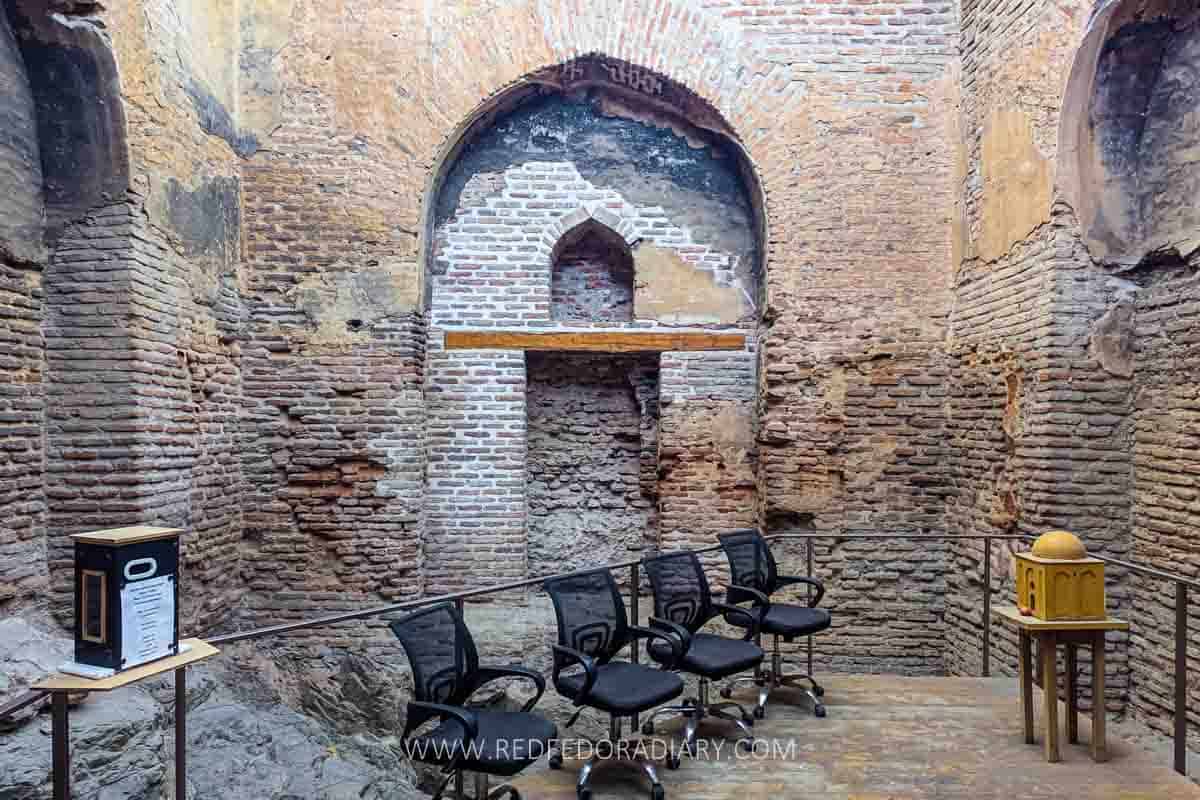
During the various reigns of Persia between the 3rd and 7th centuries, the rulers tried to establish the Iranian state religion, Zoroastrianism, in Eastern Georgia. At that time, it was the strongest competitor of Christianity, and we fought against it as much as we could. Thus, it didn’t gain popularity because some of its rituals were unacceptable to locals.
Several other such temples existed in different cities and villages, but Ateshga remains the only one. In the 1720s, it functioned as a mosque under the rule of the Turks.

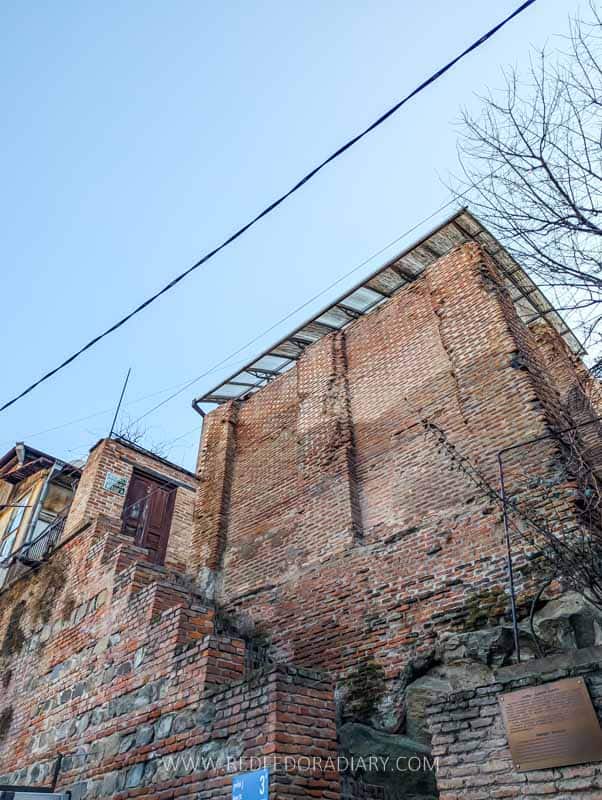
The current building allegedly dates back to the 17th century and is now part of someone’s house. However, the owners are happy for you to come by and enter; just knock on the door and wait until they open it for you.
The temple’s eastern and western parts feature preserved fragments of its arches. Although it was partly restored in the late 2000s, it is crumbling yet remains a unique place to visit in Tbilisi.
Stroll through the greenery at the Botanical Garden
Wandering through the Botanical Garden is an excellent way to get away from the crowds and escape the summer heat for a bit. The area, lodged behind the Narikala Fortress, features a variety of roses, lilacs, conifers, a bamboo lane, an orangery, a fountain, a waterfall, and bridges.
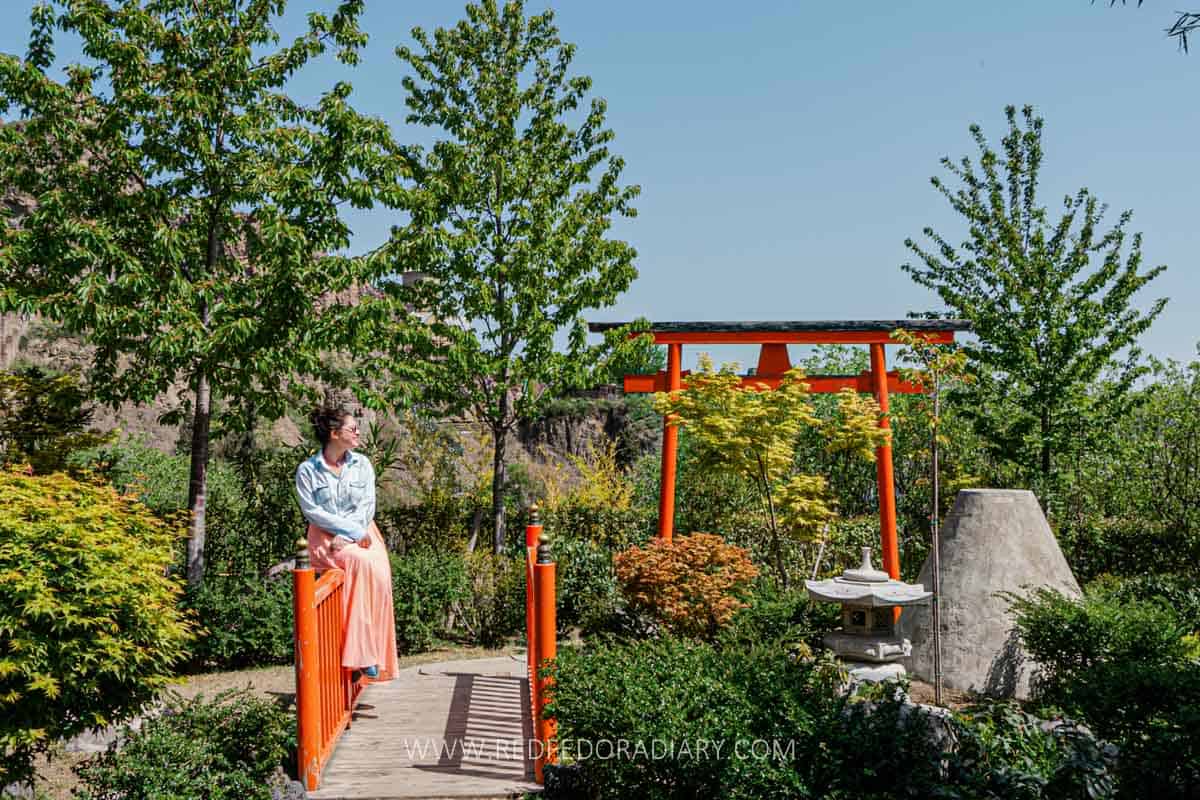
Based on the maps from 1735 to 1800, the current territory of the Botanical Garden consisted of three smaller royal gardens. In 1801, when we became part of Russia, these royal gardens were renamed Tbilisi’s Treasury Garden.
In 1845, the Viceroy of the Caucasus, Count Mikhail Vorontsov, released the decree to name it the Tbilisi Botanical Garden and granted himself the responsibility to maintain and care for it. For almost a century, the Tbilisi Botanical Garden was the only scientific center in the Caucasus.
My favorite places are the miniature Japanese garden with Sakura, Torii Gate, a Tasoutou-style stone tower for happiness and luck, a traditional red bridge, a Kasuga stone lantern, and the Lilac Garden when the trees bloom in spring.
Discover last standing mosque
Jumah Mosque, the red brick building at Botanikuri Street, is a place of worship for Sunni and Shia Muslims. It is one of the only mosques worldwide for both religious followers.
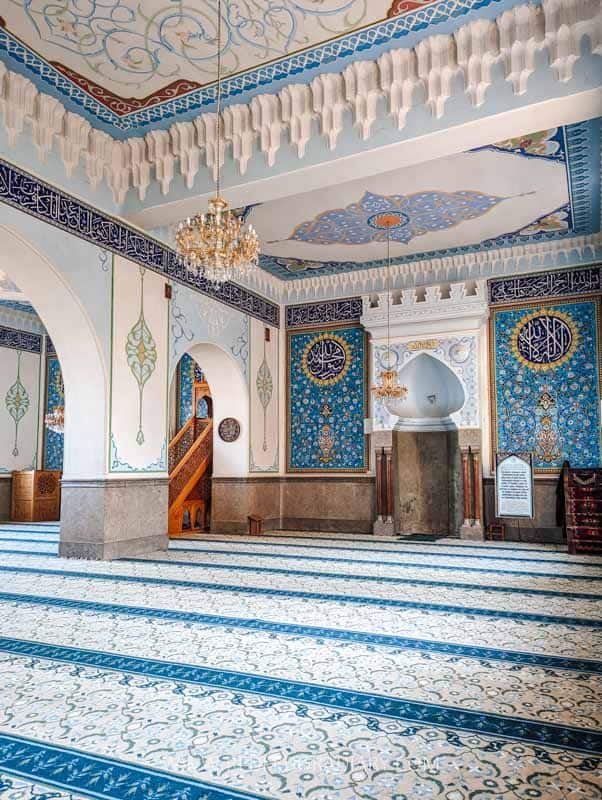

After the conquest of Arabs in the mid-7th century, Georgia’s Muslim population grew, and several mosques were constructed within its city walls. However, only the Jumah Mosque remains today.
The mosque, built by Ottomans in the 18th century as a Sunni mosque, has been destroyed and rebuilt three times over the past three centuries. Shia Muslims used to have a separate site, which was destroyed by the Soviet government in 1950 for the construction of the Metekhi Bridge.

As the Shia community didn’t have a place to worship anymore, the Jumah Mosque opened its doors to them. A black curtain divided the space for the communities to pray in separate areas, but it was removed in 1996 and is now open to everyone.
Enjoy spectacular views from Tabori Mountain
Tbilisi has several incredible viewpoints to enjoy the city from various angles and overlook the city’s different parts. But, the views from Tabori church and mountain over the Narikala Fortress, sulfur bath domes, colorful balconies, Rike Park, and Avlabari neighborhood with Holy Trinity Church are hard to beat. This is my favorite panoramic view of Tbilisi Old Town.


Tabori Hill used to have its own citadel, similar to Narikala and was another defensive fortress for Tbilisi. The fort was destroyed and rebuilt several times over the centuries and finally demolished in 1795 during the Battle of Krtsanisi.
After the annexation of Georgia to the Russian Empire in 1801, Tbilisi didn’t need defensive structures anymore, so the Tabori Fortress was lost to time. Only the leftovers of its foundation remain on the hill.
To get to the Tabori church, follow Baazov Street to the end until you notice a modern circular staircase. Walk it up, and you’ll find the newly built wooden pathway leading to the church.
Cross the Bridge of Peace
The most famous and highly controversial among locals (even today) is the pedestrian glass Bridge of Peace connecting Erekle II Street with Rike Park.
The bridge, designed by Italian architect Michele De Lucchi, was built in one year and officially opened in 2010. It is the 11th bridge over the Mtkvari River and the only one built in the 21st century.
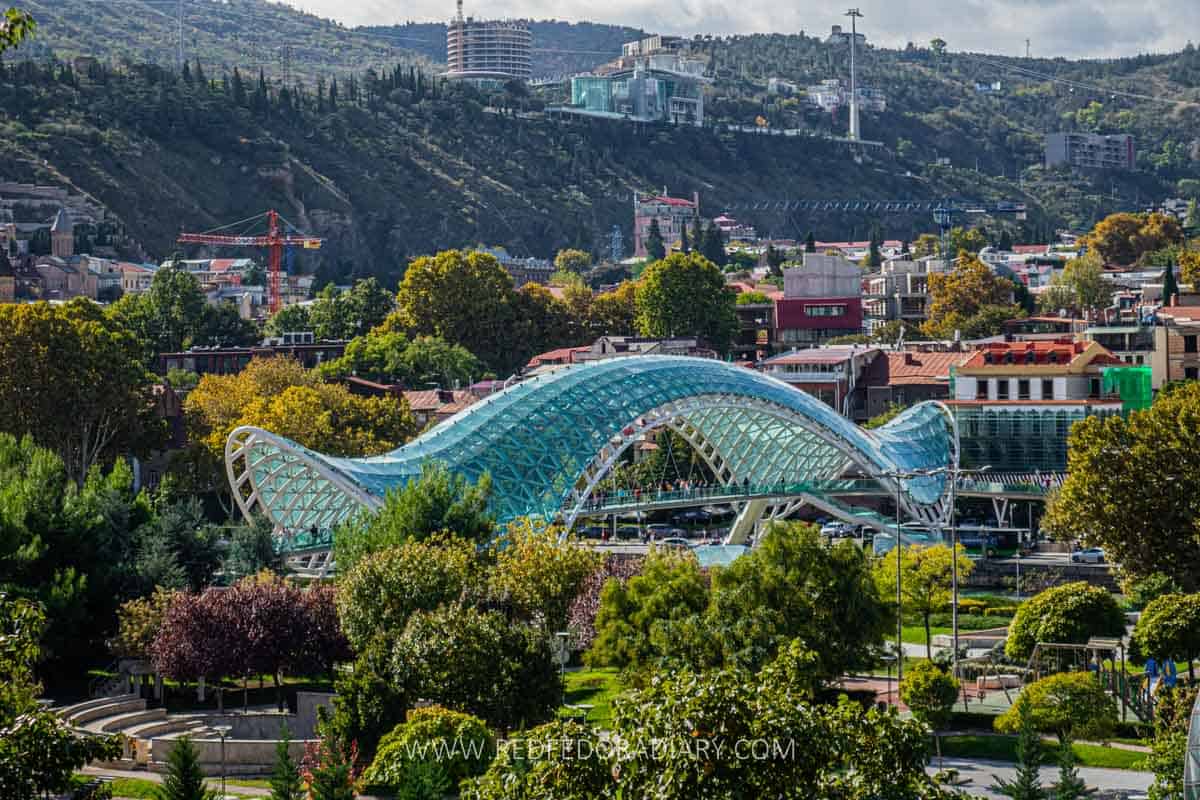
This 156-meter-long bridge features 50,000 LED lights that shimmers with an interactive light display at night. The lighting, live from 90 minutes before sunset until 90 minutes after sunrise, features four programs running every hour, created by the French lighting designer Philippe Martinaud.
Interesting fact: Placed in the historic part of the city, the Bridge of Pease received much criticism from locals and professionals, who said it didn’t fit the overall landscape of Tbilisi and covered its historic architectural landmarks. It even got nicknamed “Always Ultra” for its resemblance to a women’s maxi pad; some even called it “Misha’s (short for Mikheil) Always.”
Notice the Berlin Wall at Europe Square
Even though part of the historic Berlin Wall is visible to everyone at Europe Square, it remains a bit of a hidden gem in Tbilisi among foreigners and locals.

It was placed here in 2017 as a gift from Germany, a sign of a long-lasting friendship between the countries. It now has new graffiti that says, ‘Praise the God.’
Head to Metekhi Church
As a local, I rarely consider churches tourist landmarks and seldom include them in my Georgia guides unless they are stunning, unique, or have a particular historical significance. Metekhi Church and its territory are one of such, having historical importance.

Located on the cliff across the Mtkvari River, it is one of the oldest churches. It has been destroyed and rebuilt many times, but much of its current facades date back to the 13th century. The area also had a defensive fortress.
In 1819, the Imperial government demolished the fortress and built a new building as a prison, changing the whole architecture of the Metekhi stronghold and incorporating the church as part of the prison. The church’s exterior walls still preserve the names of the prisoners scratched on it by themselves.
During Soviet rule, specifically from 1921, it was home to NKVD (People’s Commissariat for Internal Affairs), which regularly executed convicts there. The prison was closed in 1934, and the surrounding barracks, prison, and towers were demolished in 1937. You can see the maquette of the jail in the Tbilisi History Museum.


The church was inactive for many decades. In 1979, it was turned into a youth drama theater studio with a backstage, a stage under the dome, and a theater with 100 seats. It became a place of worship only in 1988.
Additionally, the spot right next to the King Gorgasali Statue offers another great viewpoint of Tbilisi’s intricate, colorful houses wedged under the foot of the Narikala Fortress.
Overlook the city from Queen Darejan Palace
It is almost impossible to miss a circular tower with an expansive turquoise-colored wooden balcony, standing on a high ground facing the Rike Park and Metekhi Church.
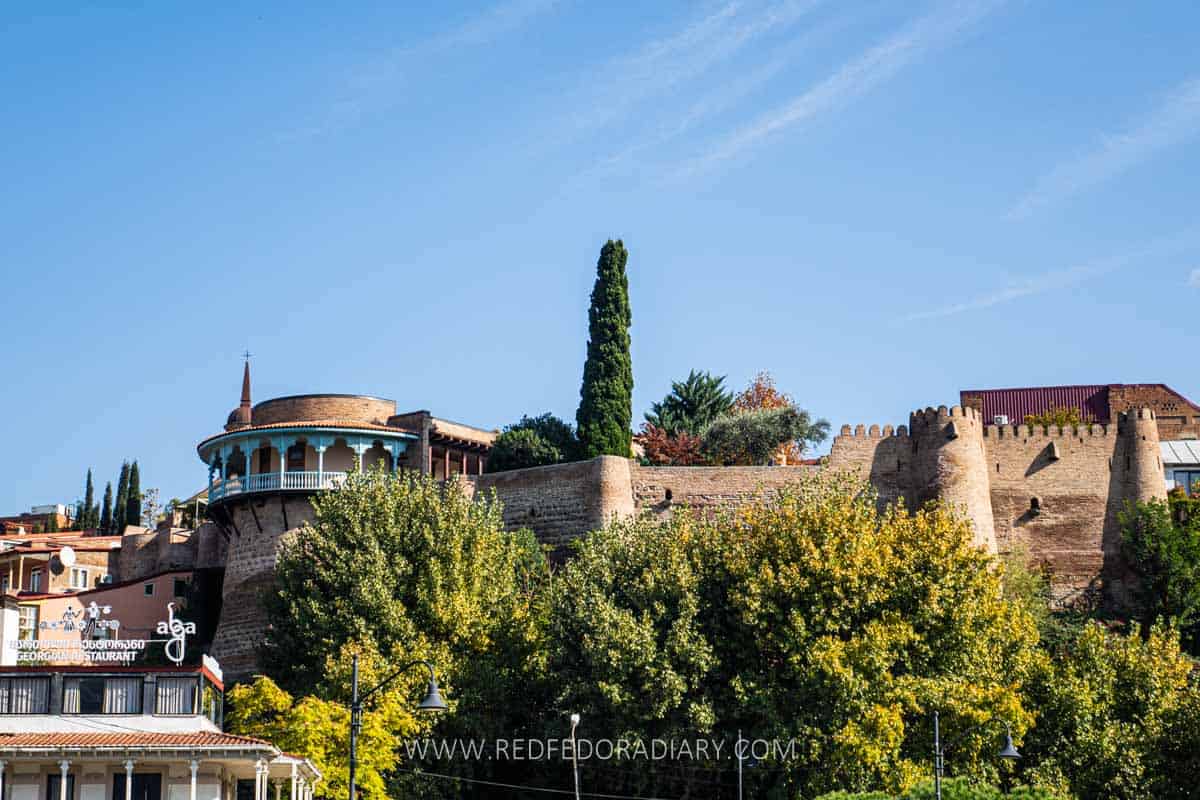
This is Queen Darejan Palace, also known as Sachino, built on the ruins of the old Avlabari citadel and city wall in 1776 for the wife of Erekle II. The palace complex consisted of apartments and various other buildings. In 1789, Queen Darejan built a small church of St. Irakli and St. Daria within its grounds. Later, it transformed into the Transfiguration Monastery.
The monastery was closed during the communist era. In the 1970s, it housed 26 Commissioner District Museum. At some point, it also served as a warehouse and one actor’s theater, with performances held until the 1990s. Since 1991, the church has been active and part of the Patriarchate.


You can visit the premises and overlook from the balcony, which offers beautiful views of the Rike Park, TV Tower and Mtatsminda Mountain, Europe Square, Metekhi Church, and Narikala Fortress with its colorful houses in the distance. It’s also a popular photo spot.
Uncover underground Meidan Bazaar
Meidan Square, currently located at the end of Kote Abkhazi Street and one end of Metekhi Bridge, used to be the main bazaar of Tbilisi. Merchants would come here to trade, and the area was full of various artisans’ workshops, which gave names to its surrounding streets (Cotton and Iron Rows, for instance).
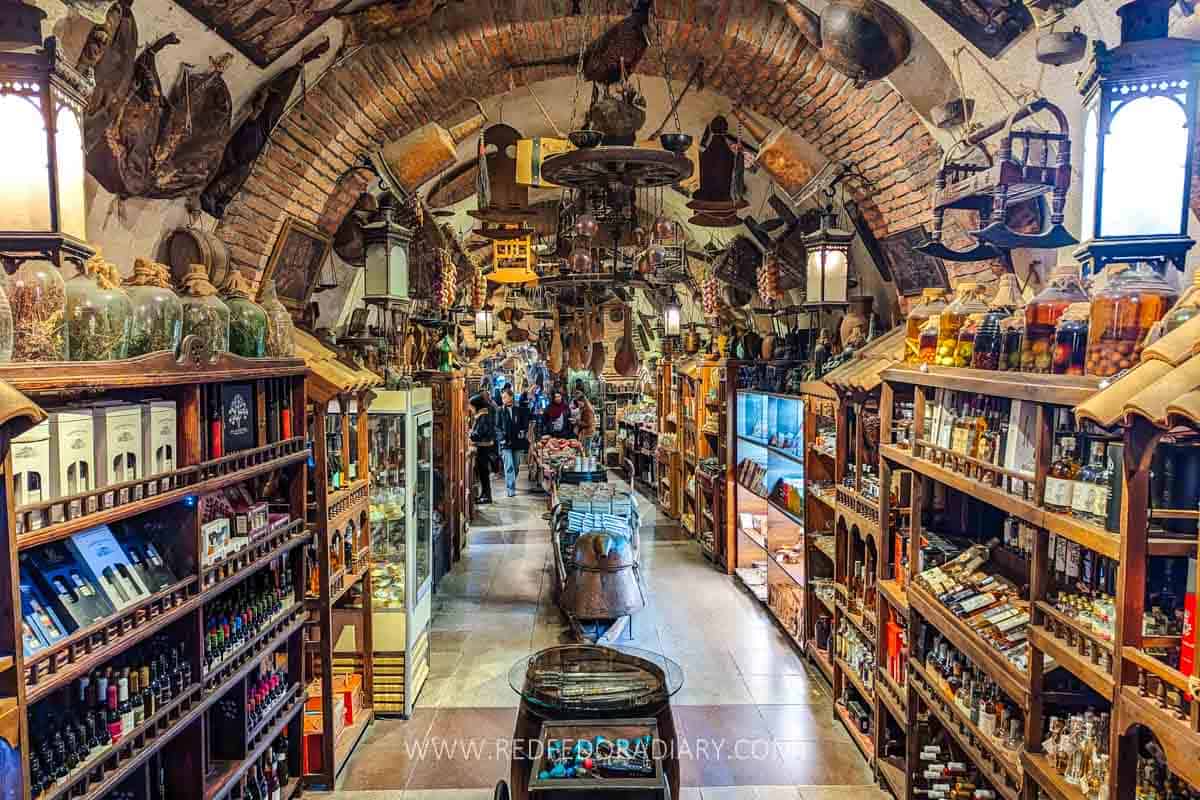
Sadly, nothing remains from the old bazaar today. Underneath is a souvenir market displaying traditional Georgian ethnographic items, snacks and sweets, jams, locally made art, clay pots, cups, bowls, and wine.
However, as a local, I consider it a tourist trap with inflated prices. Come here to see folk items that locals used in everyday life in the past. Look at the map of old Tbilisi and compare the current and old Georgian alphabets drawn on the ceiling.
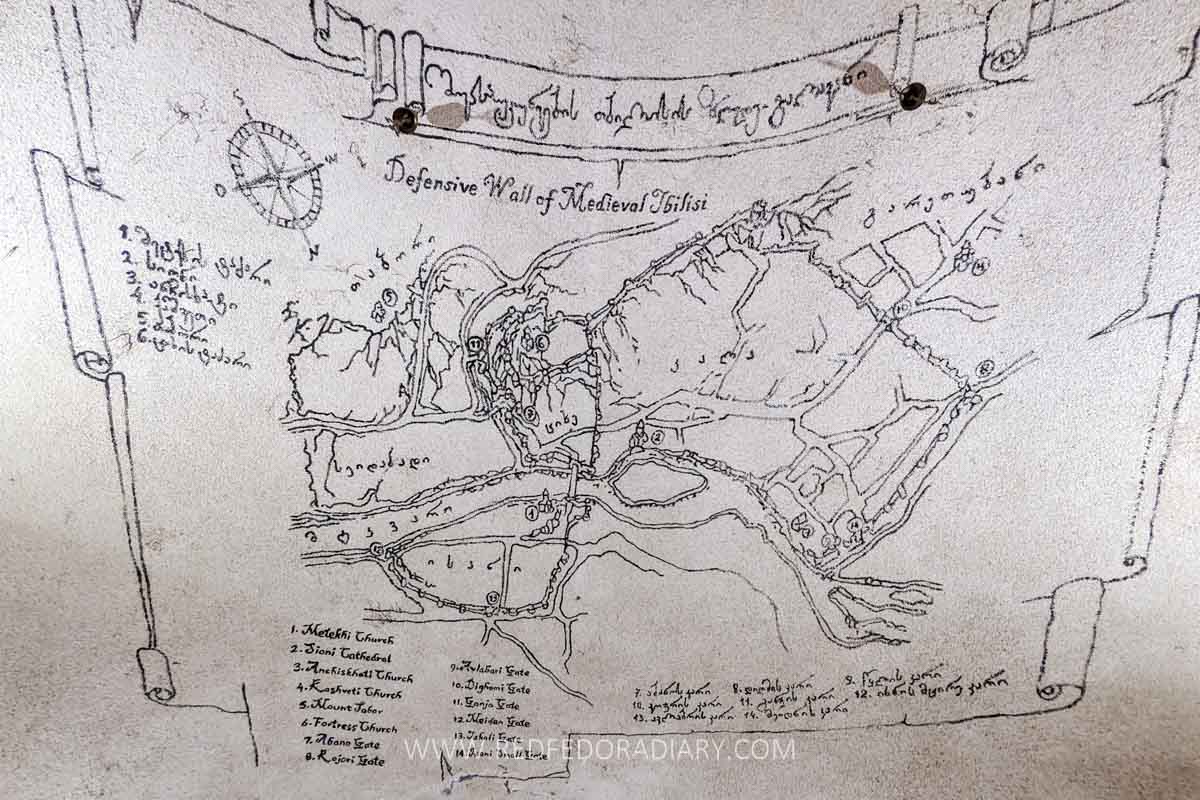
Walk through it out of curiosity, but I do not recommend souvenir shopping here. Instead, refer to my Georgian souvenir guide for more authentic items and shops, including a map.
Discover Tbilisi’s Synagogues
Tbilisi hides three Synagogues in its backstreets, of which two are active, and one currently houses a Jewish museum.
The Great Synagogue is the biggest one, built in 1910 by Georgian Jews from Akahaltsikhe city (Samtskhe-Javakheti region) who moved to Tbilisi in the 19th century. It is an Orthodox Jewish congregation and synagogue constructed in eclectic Moorish and Romanesque Revival styles and includes a mikveh (bath area).
The Ashkenazi Synagogue (Beit Rachel), also known as Little Synagogue, is a Chabad Orthodox Jewish congregation and synagogue hidden off the Kote Abkhazi Street at Tkavi I Dead End. The former domed Ashkenazi New (Second) Synagogue, completed in 1915, has been repurposed as the Museum of the Jewish People at Beit Hatfutsot since 1932.
Tbilisi also had a fourth synagogue, the Ashkenazi Old Synagogue, at the current Gia Abesadze Street. It was completed in 1875 and burned down at the end of the 19th century. Nothing from its original decoration has been preserved or restored. The building now houses the Royal District Theater.
Step inside the old Caravanserais
Being part of the Silk Road, Tbilisi had several caravanserais spread across the city, primarily concentrated in the Old Town near the Sioni Cathedral.

Most surviving ones were built in the middle of the 19th century and have similar structures. From the inside, the building features iron or wooden balconies overlooking the central yard. Caravanserai had shops, restaurants, and bars on the ground level, the basement served as a fridge, and the second floor had hotel rooms. They differed in size, levels, and stylistic architectural styles inside and out.
One of the old Caravanserais, located at 8/10 Erekle II Street, is disguised as a typical house and easy to miss if you don’t know where to look. It was turned into a residential block decades ago, but once you open the massive black gate, you step into the past.
The covered courtyard of the Caravanserai has small windows that bring in the daylight. The wooden balcony/railing overlooks the central part and often has hung clothes for drying, making it the most authentic Caravanserai in Tbilisi you can visit.

Another one is next to Sioni Cathedral, constructed in the first part of the 19th century following the aftermath of the Battle of Krtsanisi in 1795. The original Caravanserai here was built in 1650 by King Rostom.
Known as Artsruni Caravanserai, the building was significantly damaged by the fire in 1855 and reconstructed with changes. Until 1920, it functioned with its original purpose. Today, the building is home to the Tbilisi History Museum, the Wine Museum, and a few souvenir and wine shops on its ground floor.
Meet the Tamada
Tamada, or the toastmaster, is the most essential part of Georgian Supra, a big feast. The person’s function is to guide the feast by giving long and beautiful, sometimes sad and funny toasts before each round of drinking.
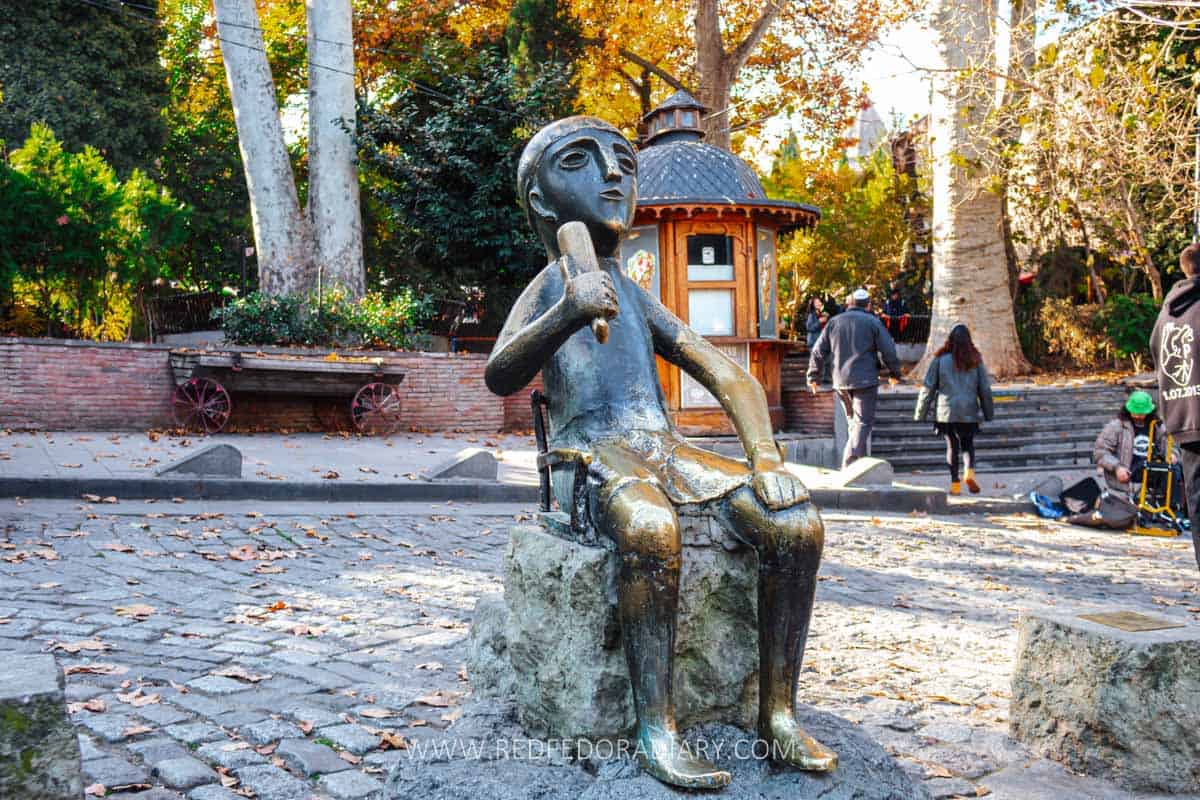
There is only one male Tamada at each Supra, but he also chooses his assistants and encourages others to give toasts. It is customary to listen to whoever’s saying the toast and not interrupt.
A few steps from Sioni Cathedral and the beginning of Chardin Street, you’ll find a statue of Tamada holding a horn—a typical drinking vessel. It is a replica of a tiny bronze statue from the 7th century BC found in Vani’s archeological site.
Find solace at Gudiashvili Square
Tucked away from the main streets and halfway between Old Town and Freedom/Liberty Square, this newly renovated square is perfect for taking a break from Tbilisi sightseeing.
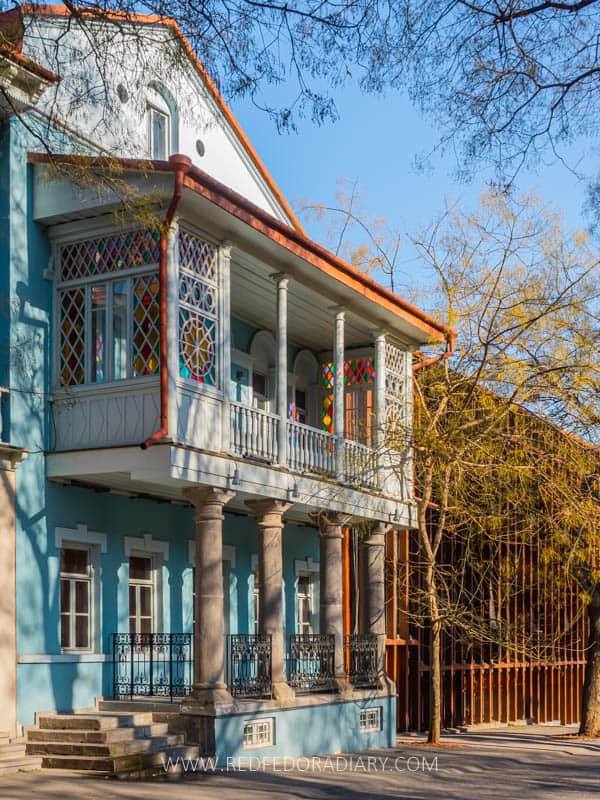

Sit in the center, watch people pass by, listen to locals chatting, and admire some great examples of art nouveau buildings around it. If you want to prolong your break, there are a few eateries and bars.
Ferments is my go-to wine bar, while Lado by Valiko Mansion offers delicious cocktails. Grafika has tasty food, while Racha is a relatively cheap Georgian tavern. I used to go quite often, but since it became very touristy and inflated prices, I stopped. Pur Pur is a vintage-themed cafe great for coffee and dessert.
See the remnants of the old wall
Historically, Tbilisi’s city walls from its central area came up partly on today’s Asatiani Street, made a turn at the corner of Dadiani Street, continued to the Freedom/Liberty Square and Pushkin Street, turned onto Baratashvili Street, and followed along the Mtkvari River to rejoin at the Abanotubani.


In 2012, the government started an expansion project on Pushkin Street to widen it for car traffic and discovered a 110-meter-long old wall with five towers. According to archeologists, these walls have several layers from the 12th century to the 18th—evidence of Tbilisi’s repeatedly destroyed and rebuilt history.
Because it is such an important Tbilisi attraction, the authorities left it open and created a walking path so you can get close to it. Therefore, many tourists miss it entirely or walk over its pedestrian path without realizing what it is.
A few other parts of the wall are also visible along Baratashvili Street, with crumbling houses adorned with wooden-carved balconies built on top of the wall.
Spot the oldest Arabic inscription
Along with the various cultural and household items found during the reconstruction of Pushkin Street, the archeologists also found the oldest Arabic inscription Tbilisi preserves today.

The inscription, dating back to the 8th century, is on one of the defensive walls. When discovered in 2012, it had six lines, but scholars could only partially read the last two, believing it was in the Kufic style.
Vandalized a while back, it now has a protective cover. The letters are barely visible, and there is no information on what the writing says, but it still is a fascinating item from ancient Tbilisi.
Watch the puppet show at Clock Tower
The leaning Clock Tower opened in 2010, has become one of the most famous Tbilisi landmarks. It is a masterpiece of Rezo Gabriadze, a well-known Georgian theater, filmmaker, playwright, painter, and sculptor.
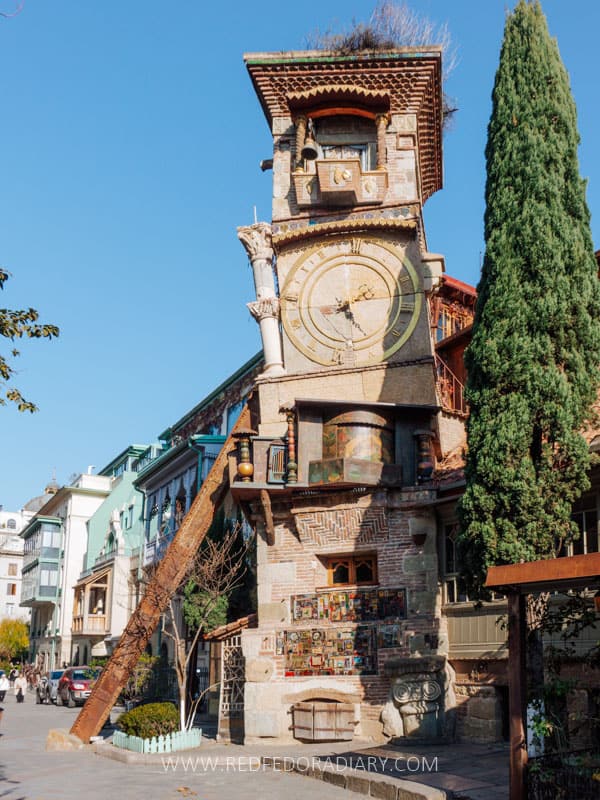

This unique clock tower was constructed using repurposed bricks from old house ruins, and the metal pole on which the tower is leaning is a preserved piece from one of the old bridges. On its bottom, you’ll find two massive ceramic decorations. Each of the hundreds of tiles is entirely crafted and handpainted by Gabriadze himself. Also, make sure to find the city’s most miniature clock there.
At every full hour, an angel emerges from the decorated door at the top of the tower above the clock and rings the bell with a small hammer. Additionally, at noon and 7 pm, you can watch the small puppet show called The Circle of Life.


Next to it is Rezo Gabriadze’s Marionette Theater, which offers very interesting and thought-provoking plays for adults. If you have time, I recommend seeing Ramona or The Autumn of My Springtime. The tickets sell out fast, so once you know your plans, check out Tkt.ge to buy them.
The complex also has a cafe with vintage decorations and a souvenir shop at the begining of the street selling various items with Gabriadze’s sketches.
Take a glimpse into oldest church
The Anchiskhati Basilica of St Mary is the oldest surviving church, dating back to the 6th century. Much like many Tbilisi landmarks and churches, it was rebuilt several times during the 15th and 17th centuries due to ongoing wars between Georgia, Turks, and Persians.

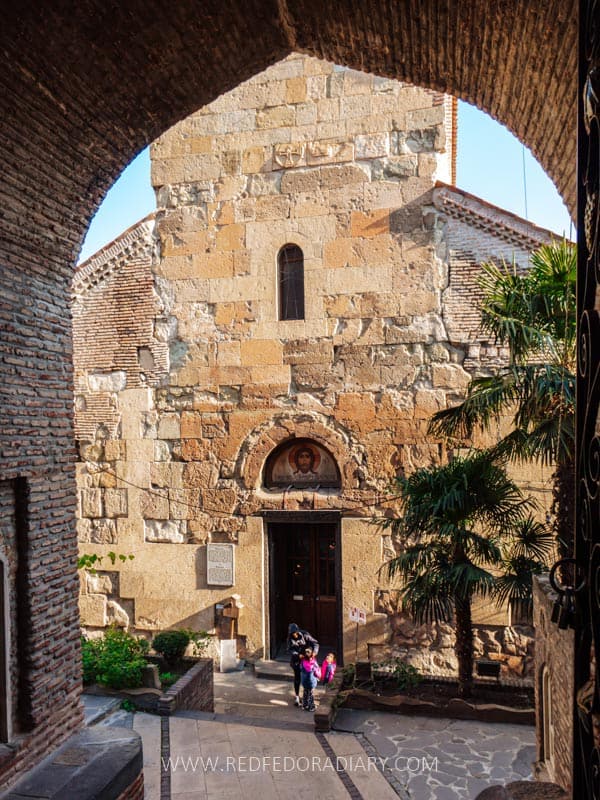
In the 1870s, the dome was added to the church, drastically changing the original building. As the Soviet rule banned all religious events at all worship places, Anchiskhati served as a museum of handicrafts and later as an art studio.
From 1958 to 1964, the basilica was renovated as part of the festivities to celebrate the 1500th Jubilee of Tbilisi and returned to its look in the 17th century. It reverted to religious use only in 1991, after the collapse of the Soviet Union.
The frescos inside are stunning, so I encourage you to peek inside. Besides the altarpiece painted in 1683, the rest is from the 19th century.
Don’t miss out on trying the Royal Candy
Kaklutcha, often called Orbeliani’s Candy or Royal Candy, is a Georgian sweet/dessert created by Princess Mariam Jambakur-Orbeliani, a noblewoman, feminist, and daughter of esteemed 19th-century Georgian poet Vakhtang Orbeliani of the House of Orbeliani.


This exquisite treat is surprisingly simple, made with just two ingredients—walnuts and caramelized sugar. Yet its rich flavor and delightful texture make it flavorful, tasty, and filling.
Although Kaklutcha is a rare find in Tbilisi, you can savor it at Cafe Leila, opposite Anchiskhati Basilica or Shemomechama.
Other popular activities
Once done walking through the Old Town and getting the feel of the ancient Tbilisi, it’s now time to explore other parts. Tbilisi’s New City (although we don’t call it that) developed outside of the ancient city walls from the start of the 19th century and covers the areas of today’s Freedom/Liberty Square, Sololaki district, and along Rustaveli Avenue.
Additionally, this section provides a few other iconic landmarks to visit in different areas, such as the Avlabari, Mtatsminda, and Chughureti neighborhoods.
Discover the modern architecture in Tbilisi
Our third president, Mikheil Saakashvili (from 2004 to 2013), came into power with the main goals of making massive reforms and turning Georgia into a modern country.
He did this successfully until he became uncontrollable with too much power. Part of this process was building funky modern architecture nationwide, and a few dot today’s cityscape.

Besides the Bridge of Peace, I mentioned earlier, other notable modern architectural examples are the Public Service Hall, or as locals call it ‘ the mushroom house’ that actually represents flowers but indeed looks like mushrooms, the former President Residence in Avalbari, the massive building with a glass dome overlooking the Bridge of Peace that resembles the White House, and two giant metal tubes in Rike Park that were built as exhibition and concert halls, but stays abandoned since its construction.
Appreciate the architectural mix of Rustaveli Avenue
Rustaveli Avenue is the primary, 1.5km long, street of Tbilisi city center featuring some of the town’s most significant buildings. It has also witnessed a few cruel events in the past, the most tragic being April 9th, 1989, when the Soviet army thrashed the pro-independence peaceful demonstration, resulting in hundreds of injuries and 21 deaths.

Named after Shota Rustaveli, a medieval poet, author of The Knight in the Panther’s Skin (we learn this poem at schools from very early grade), and one of the important contributors to Georgian literature, the avenue utterly tells the grandeur of capital.
The road, lined with trees on both sides, showcases a blend of Soviet, modern, and art nouveau-style buildings, various shops, museums, an art gallery, and eateries. There are at least a dozen landmarks on Rustaveli Avenue, but ensure you see these iconic ones: the Soviet-era Academy of Science, Biltmore Hotel, and Parliament of Georgia, Moorish National Opera and Ballet Theater, and art-nouveau Rustaveli National Theater and Tbilisi Marriott Hotel.
Visit the main square of modern Tbilisi
Freedom Square (also known as Liberty Square) is the city’s primary square. It serves as the border between Old and New Tbilisi and the starting point of Rustaveli Avenue, along with Pushkin, Leonidze, Dadiani, Tabidze, and Apkhazi streets.


When we became part of the Russian Empire in 1801, Tbilisi’s urban layout slowly expanded outside of its walls, right in this area. Before that, it was referred to as Garet Ubani or ‘outside district’ if translated directly from Georgian.
In its 200-year history, the area has undergone several urban and name changes. The Imperial government named it officially for the first time in 1829 as Paskevich-Erivansky Square, or simply Erivansky in short, after Ivan Paskevich, general in the Imperial Army and Count of Erivan (today’s Yerevan, Armenia), who conquered Yerevan during the Russo-Turkish War in 1828–1829.
In 1917, when the Tszar was overthrown in Russia, the local revolutionists named it the Freedom/Liberty Square. However, after Sovietization, it changed its name several times.
At some point, it was named Lavreti Beria Square after the famous and cruel secret police chef for Joseph Stalin, and later, after Lenin. His statue was placed in the center; my mom still calls it Lenin Square. When we gained independence in the 90s, it returned to Freedom/Liberty Square.

The square has always featured important landmarks, but only a few remain today. At the territory north of the square, at the end of the 17th century, we had one of the biggest Royal Caravanserai, having up to 80 rooms.
However, it was destroyed by Turks invading the city in 1724. The Headquarters of the Caucasus Corps, constructed in 1824 right between the Courtyard Marriot and Galeria Mall, and the Art Museum of Georgia of 1825 are among the oldest surviving buildings.
In the 1830s, south of the square, where today stands the City Assembly, the pink Moorish building with the clock on top, we had the city police office with a tower for the fire unit.
In 1851, allegedly, the most beautiful and first Opera House (back then known as Tiflis Imperial Theater) in the Caucasus and Imperial Russia opened its doors to the public, designed and built by Italian architect Giovanni Scudieri. Sadly, the fire destroyed it in 1874. Only a few scratches and the architectural plan of the building (hang up in the Art Palace Museum) remain.

Since 2006, St. George’s Statue dominates the center of the square. It was created by Zurab Tsereteli, the famous sculptor and author of the Chronicles of Georgia (see below), as a gift to the city devoted to the sovereignty and freedom of Georgia. Standing on a 29-meter-tall column, the statue is made of bronze, weighs 27 tons, is plated in 2 kg of gold, and is 5.6 meters tall.
Tour the grounds of the tallest cathedral
Sameba, or Holy Trinity Cathedral in English, is the main cathedral of the Georgian Orthodox Church, visible from almost every corner of the town. At 87.1 meters from the ground to the tip of the Golden Cross, it is the third-tallest Eastern Orthodox church in the world and one of the largest by area.
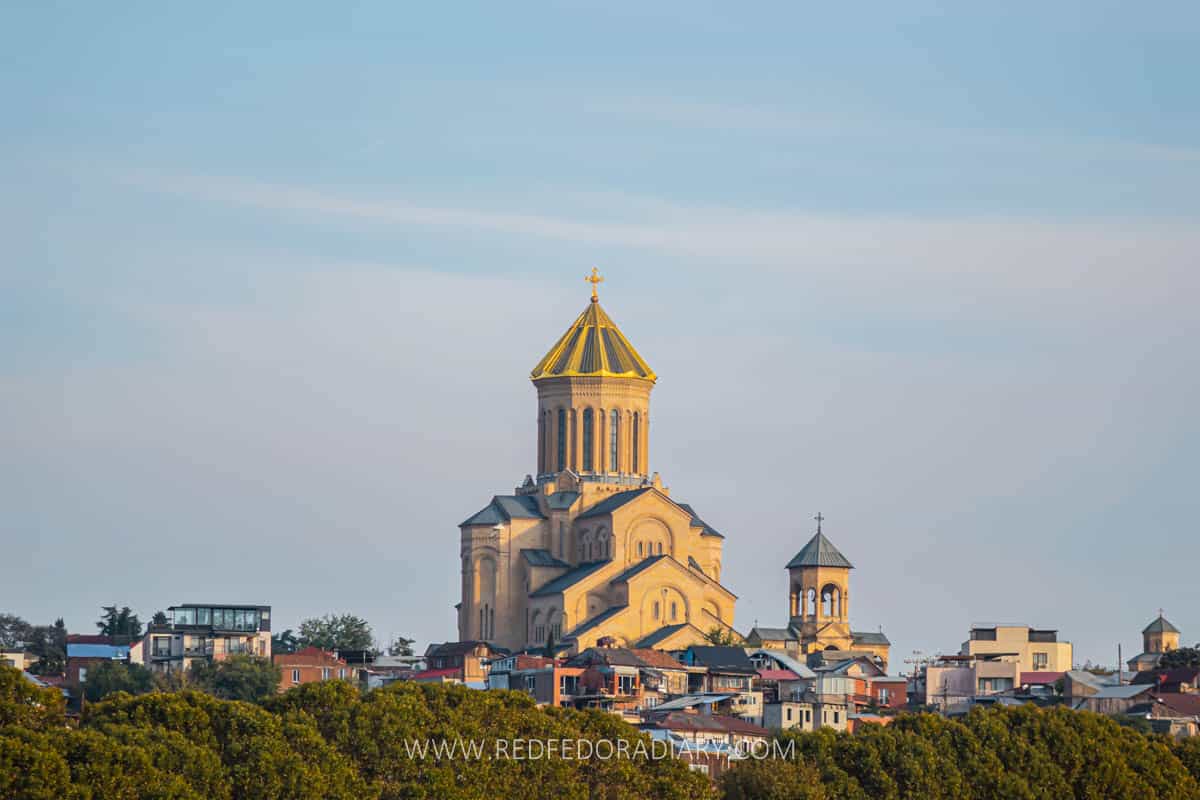
It took almost ten years to construct Sameba, and it finally opened in 2004 to commemorate the 1500 years of the Georgian Orthodox Church and 2000 years after the birth of Jesus. The building features a mixture of Georgian traditional church architecture with undertones of Byzantine style.
Located in the Avlabari neighborhood, a bit far from the city center, the Holy Trinity Cathedral is worth the slight detour to admire its unimaginable size and city views from its grounds.
Spend an evening at the trendiest spot
The complex incorporates a hostel, co-working space, various ceramics, vinyl, clothes shops, a barber place, a photography lab, a natural wine bar, and several cafes and restaurants, serving burgers, pizza, tone bread (baked daily in the courtyard) sandwiches, etc. My favorites are Moulin Electric and Tone.


The lobby of Fabirka, designed with vintage furniture and towering plants, is a cozy place to relax, grab a drink or lunch, meet people, or enjoy your time here.
When the weather gets warm, Fabrika’s courtyard becomes the most popular spot to hang out, especially on Friday evenings and weekends. If you are spending Christmas and New Year in Tbilisi, it hosts its annual Christmas fair in mid-December.
Browse and buy local produce at the Deserters Bazaar
Deserterirebi, or Dezerter Bazaar, named after deserters of the Tszar’s army who supposedly started selling their equipment and weapons here more than a century ago, is a vast covered market close to the Tbilisi Central Railway Station.
You won’t find army gear today, but you’ll be welcomed by the abundance of local fresh produce, from wholesalers selling trucks full of various veggies to smaller vendors of spices, tkemali (plum) sauce in repurposed Coca-Cola bottles, fresh herbs, towers of Georgian cheese, and Churchkhela, to name a few.
Wandering local markets is my favorite activity, whether traveling or not, as it gives the whole picture of the country’s cuisine. Consequently, this one gives you a good idea of the ingredients for preparing Georgian food. Being closer to the city center, Dezertirebi quickly became a touristy place with slightly high prices. Below, I list a more low-key alternative under the local things to do in Tbilisi headline.
Sellers are friendly and used to foreign visitors. Many will try to get your attention in broken English or Russian and get you to try a free sample of their produce. It’s an integral venture worth experiencing!
The bazaar is open daily from as early as 7 am and gets busier on weekends, so arrive early to browse the stalls more peacefully or come later to see the real hustle and bustle. If you want a hands-on experience with the best nooks and stalls, Paul from Meet Me Here in Tbilisi hosts a Dezerter Market tour.
Search for memorabilia at Dry Bridge Flea Market
Dry Bridge Market, or Mshrali Khidi (meaning dry bridge), is the most popular vintage market in the city. It is located in the center, a short walk from Rustaveli Avenue, and spread across Deda Ena Park.
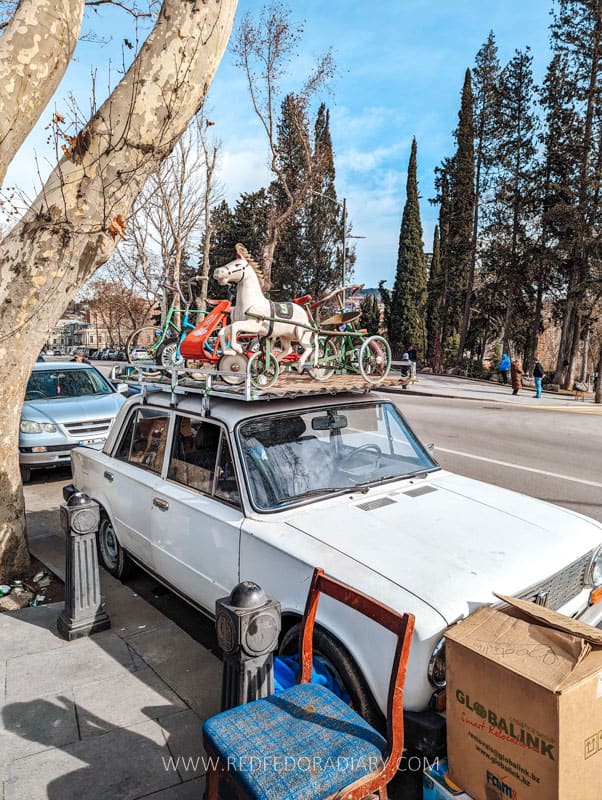
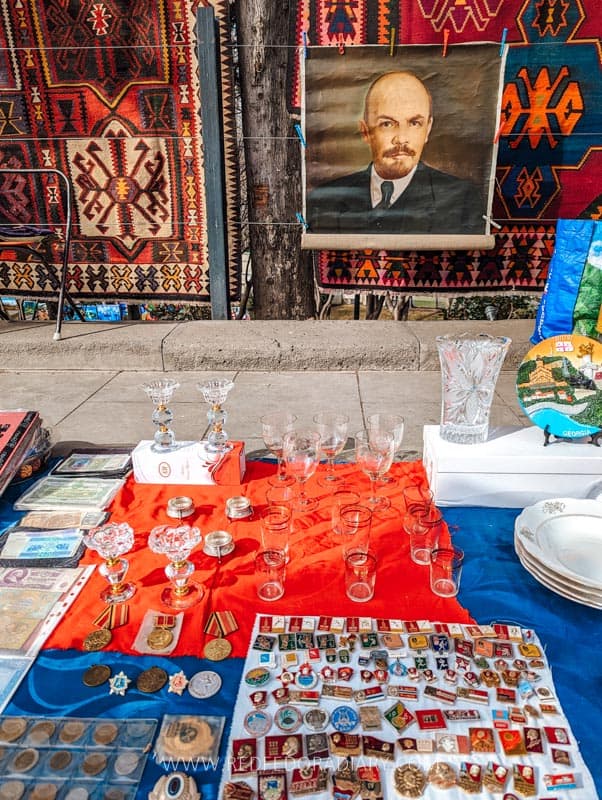
It is a paradise for those who love antiques and random vintage items, from old Soviet medals to posters, second-hand cameras to old vinyl, porcelain china to silver utensils, various decor items to furniture, TV remotes to tools, etc. You can find anything here!
The market’s origins come from the dark 1990s when Tbilisi experienced a chaotic period: civil wars, no jobs, a food shortage, and no electricity or heating. For many people, it was a fight for survival to get money to bring food home. Therefore, whoever had anything valuable at home came out here, laid the blanket on the pavement, and started selling. Even today, locals bring items they no longer need for the vendors to resell.

Like the Deserters Bazaar, Dry Bridge Market has become a touristy place. Vendors are accustomed to foreign visitors but rarely budge on prices. Like the bazaar, this market also has a relatively less popular alternative listed below.
The market is open year-round daily from 10 am to 7 pm. Warmer weather and weekends bring out more vendors with more items and stalls to browse.
Enjoy panoramic views from the Mtatsminda Park
Mount Mtatsminda is home to Mtatsminda Amusement Park and a TV Tower that dominates the Tbilisi skyline. Perched on top of the hill, it is the highest point distinctly visible from the Old Town and offers another excellent vantage point for panoramic city views.
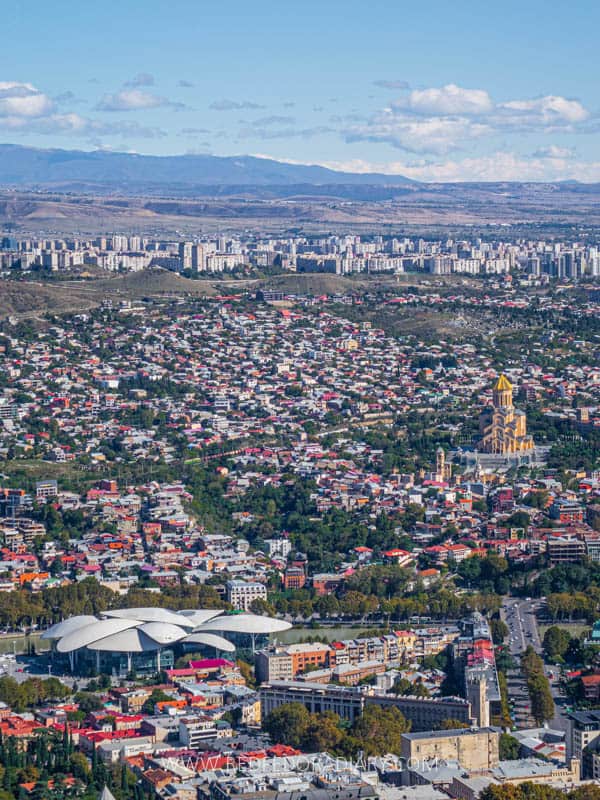
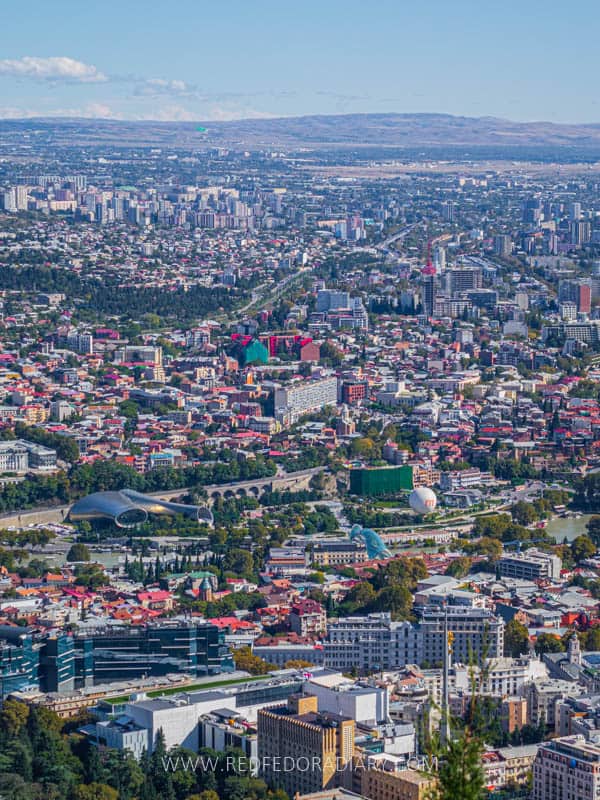
There are four ways to get to Mtatsminda Park. The newly reopened Soviet-era cable car right from Rustaveli Ave behind the steps of the Academy of Science; a Funicular Tram from Chokadze Street (uphill from Rustaveli Ave); a bus 364 from the bus stop in front of the Academy on Rustaveli Ave and hiking up. Refer to my Tbilisi public transport guide on how to use cable car and the funicular tram.
The amusement park features water slides, carousels, a roller-coaster, and a giant Ferris Wheel. It also has a few booths providing food, snacks, and drinks, but I typically go to the ground floor of the Funicular Restaurant building to eat a specific pastry and drink my childhood favorite lemonade I talk about below under the things to do in Tbilisi for foodies title.

If you are up for some adventure, Mtatsminda Park is the base for a few hiking trails you can enjoy. Easy walking paths lead to Narikala Fortress, down to the Mtatsminda neighborhood with a Mtatsminda Pantheon (the beautiful burial ground of famous Georgian public figures) in the middle, and even to Kus Tba (Turtle Lake) and Kojori townlet.
Shop for souvenirs and local designer clothes
When traveling to a new destination, one of the most exciting ways to bring a piece of the experience back home or to loved is through unique souvenirs. Georgia is also famous for its outstanding craftsmanship. From intricate traditional crafts to delicious local delicacies, Georgian souvenirs are as diverse as the country.


If you are after local designer clothes and accessories, Tbilisi won’t disappoint. Vogue, the New York Times, and Forbes have spotlighted it as an emerging fashion hub. The country has a long history with textiles, silk, sewing, and crocheting, and the capital is home to many designer shops offering unique pieces.
Refer to my detailed guide and a shopping list with a map of what and where to buy in Tbilisi.
Learn more about Georgia in its museums
Tbilisi’s museums explore the nation’s ancient roots, its role at the crossroads of East and West, and its evolving identity in the modern world through exhibits of antique tools, gold treasuries, folk items, Soviet archives, and contemporary art.
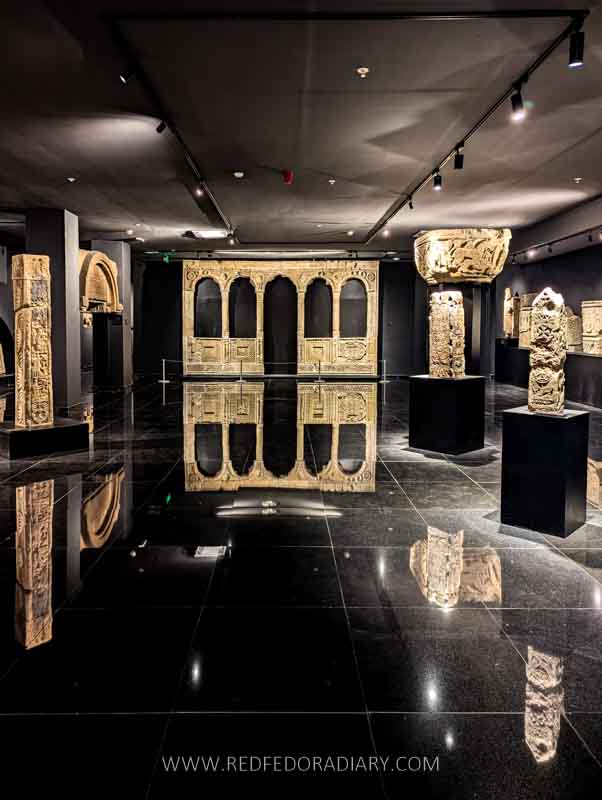

They are also a great addition to your Tbilisi itinerary when the weather is not lovely enough for outdoor walking, or you need to spend a day differently.
For a more thorough overview of the best museums and galleries to visit, refer to my complete Tbilisi museum guide. I especially love the Archeological Treasury at the Georgian National Museum, Silk Museum, Art Palace, Art Museum of Georgia, and Tbilisi History Museum.
See what’s inside Tbilisi’s courtyards
One of Tbilisi’s charms that almost every traveler loves is its courtyards tucked away from the sight, hidden behind the European-style facades and weathered gates.

Tbilisi’s courtyards, often called “Italian yards” by locals, are the soul of the city’s neighborhoods. They feature intricate wrought-iron or wooden staircases, lush grapevines climbing pergolas and poles, laundry hanging for drying, and beautiful open wooden-carved balconies or shushabandi, almost floor-to-ceiling glass windows that sometimes are part of the living spaces or used instead of the plane wall for the corridors.
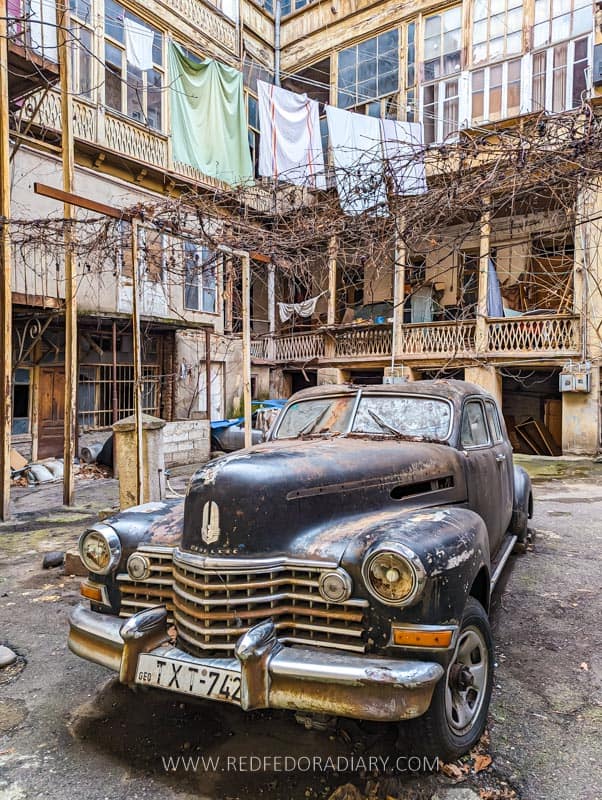

These courtyards come in various sizes and shapes and almost always have trees and vines. Some are kept clean, while others might have overgrown weeds and old discarded household items. Regardless, they’re among the unique things to see in Tbilisi! Read my article explaining the origins of these courtyards and why we call them Italian.
Please Note: When visiting residential areas and courtyards, please respect their privacy, don’t be loud, and don’t wander through their living quarters.
Go on a self-guided street art walk
I am a big lover of beautiful and meaningful street art and murals. Luckily, over the years, Tbilisi has become a canvas for this contemporary art form thanks to two projects: the Niko Movement and Georgia Mural Fest.

Each year, more and more new murals appear instead of the dull, grey walls of residential houses and underground passages. Most of these murals are scattered across the various neighborhoods, with the majority concentrated in Varketili and Saburtalo, the city’s outskirts, and a few in the city center.
I personally scout them as soon as they appear, and constantly update my Tbilisi mural guide and include a map with exact locations.
Capture great photos at the best locations
Tbilisi is a picturesque city with numerous great photo spots you can stumble upon while strolling through its fixed-up or wrecked streets.
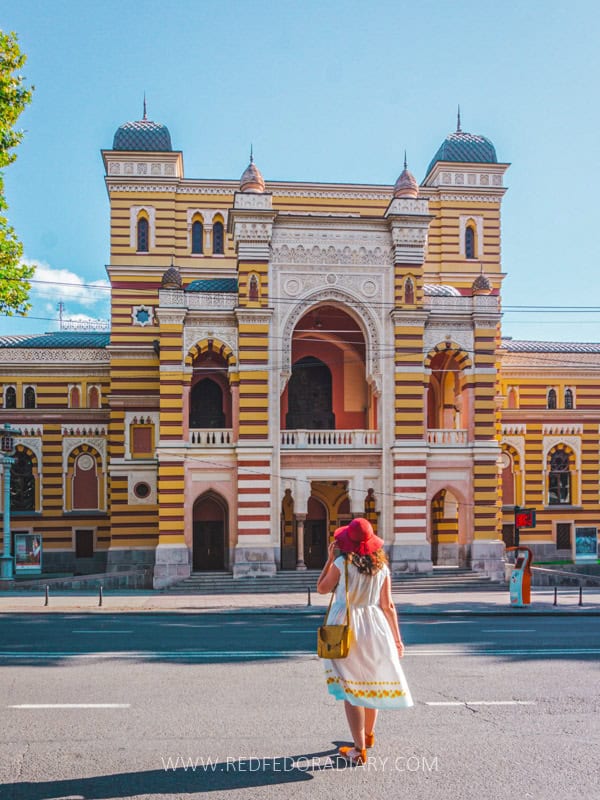
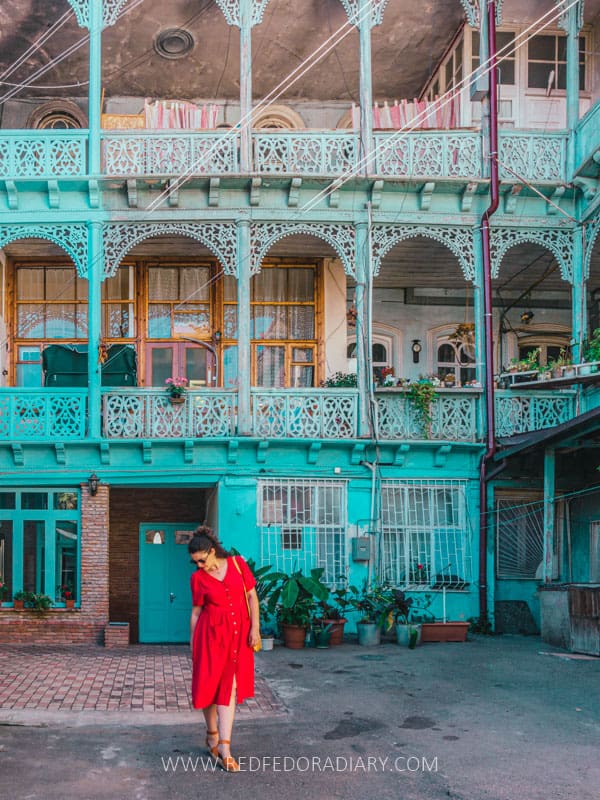
Whether you like photographing iconic landmarks, scouting for hidden gems tucked away in alleys, being drawn to the pastel-colored facades of Old Tbilisi, or wanting different-angle shots of famous places, Tbilisi can surprise you at every corner.
And if you love planning your shots and want to know beforehand what options you have for those great Insta-worthy photos, I have a dedicated Instagrammable locations guide that includes both popular and less-known sites.
Gaze at Hogwarts school
At the end of Dadini Street, just off Freedom/Liberty Square, is the only neo-Gothic building in Tbilisi. Originally built by a German architect as a German language school for only females from noble families, it has always stayed true to its original purpose of being an educational place.

Over time, it became a school for all genders and remains a private Number 6 German School preserving Tbilisi’s and Georgia’s long history of German heritage.
Because of its spires, overall look, and being one of the oldest remaining schools, locals started calling it the ‘Hogwarts school’ after the screening of Harry Potter movies.
Local things to do in Tbilisi
Tbilisi reveals its magic in the little details that locals cherish, but tourists often overlook. Beyond the postcard-perfect landmarks, there’s a lot more to discover. Even though I have lived here for over 30 years, I stumble upon lesser-known places and areas daily or see things I haven’t noticed before.
This section uncovers unique activities and places beyond the ordinary tourist route and provides alternative areas to popular spots, helping you discover the city like a true local.
Look at the Presidential Palace at Orbeliani Square
Located a short walk from the Freedom/Liberty Square on recently renovated Atoneli Street, the current Presidential Residence of Madam Salome Zurabishvili was originally a residence of the Orbelian family and still referred to as the Palace of Orbeliani, allegedly constructed in the late 19th century. Both the architect and the exact dates are unknown.
In the past, the family often organized events, inviting representatives of high society and the elite of that time and hosting the honored guests of the capital. Sadly, the original manor was destroyed at the end of the 19th century.
After Sovietization, authorities confiscated the palace from the family and turned it into the office of the Georgian Society of Friendship and Cultural Relations with Foreign Countries (ГОДИКС), which worked there until the collapse of the Soviet Union. In the 90s, it was home to the US Embassy.
Today, the Palace of Orbeliani is used for official meetings and receptions of the President of Georgia.
Take in the beauty of the National Library staircase
The National Library of Georgia is one of the best-kept secrets of Tbilisi despite its central location just off Rustaveli Ave and Freedom/Liberty Square.


The library has two buildings across the street from each other that are worth stopping by and seeing from both inside and outside. One of them is home to the Book Museum (included in my museum guide), displaying rare books and the oldest Georgian prints.
This part of the building has one of the most stunning staircases, with handpainted ceilings and wall decorations. Besides the museum entrance, this part of the building seems to have been left and turned into storage, with shelves, cabinets, and books collecting dust.
Get awestruck at the halls of the Academy of Arts
The Tbilisi Art Academy, built in the 1850s, is often overlooked by tourists because it is still relatively unknown to the internet.
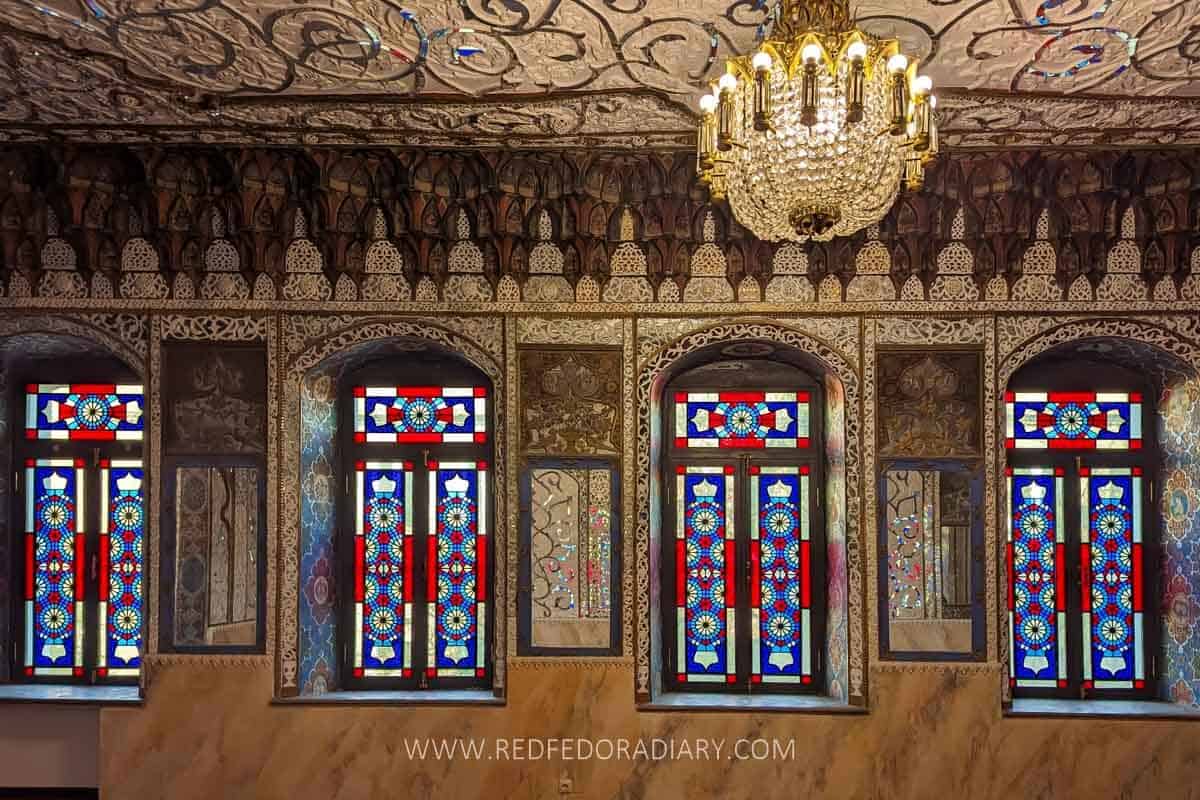
The building, blending European and Persian influences on its exterior, hides even more beautiful details from the inside. Its crowning glory is the so-called Mirror Halls – breathtaking tiny mirror mosaic rooms crafted by Qajar artists from Iran.
After a lengthy renovation of the building, the rooms have been turned into a museum (also included in my museum post). When you enter the museum grounds, a charming mirrored fireplace in the small entryway greets you instantly, leading into other magnificent halls. These chambers are nothing short of magical, leaving most visitors speechless.


The Mirror Halls are a true masterpiece of Āina-kāri – an intricate technique of covering surfaces with shimmering mirror glass from floor to ceiling. Delicate details like miniature paintings, sculptures, muqarnas, and colorful stained glass windows with mashrabiya patterns add even more charm as the sunlight dances across the mirrors and fills the room with dazzling reflections. It’s one of my favorite hidden gems of Tbilisi.
Finding the museum can be tricky. Enter through the door closer to the garden gate, walk up three sets of stairs to the second floor, then take a left into a small hallway. The brown door with an information board is on your right.
Uncover art-nouveau lavish buildings
One of the things that surprises many travelers is the sheer number of lovely art nouveau-style buildings in the city’s old neighborhoods.

I was guilty of not knowing this part of Tbilisi’s history until about ten years ago when my brother showed me one of the most stunning hallways that I had no idea Tbilisi had.
It impacted me so much that I couldn’t let go, so I started researching places, paying more attention to the buildings, and finding stories connected to the owners. Sadly, many locals are still unaware of the early 20th century Tbilisi and what it might hide behind the doors.
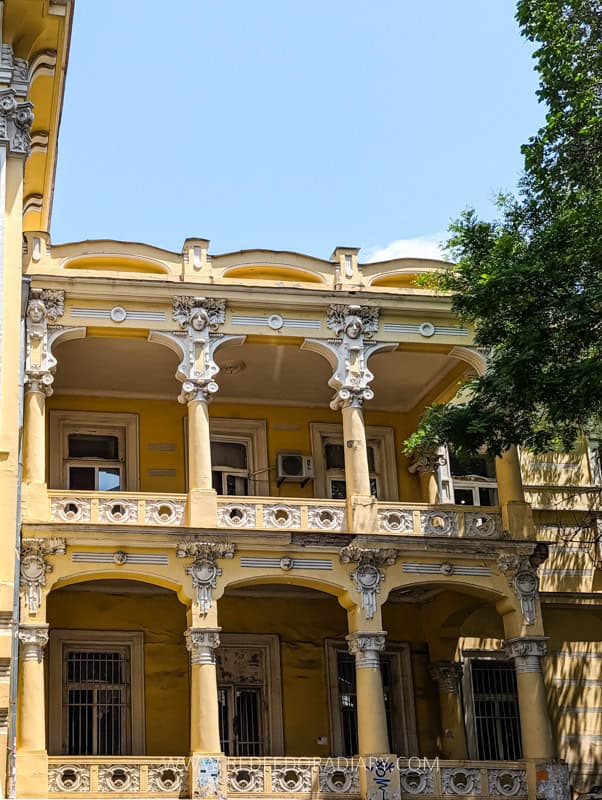

Sololaki, Mtatsminda, and Chughureti neighborhoods are great areas to walk through and discover exquisite buildings adorned with floral motifs, giant mythological creatures, cherubs, and animal faces.
Unfortunately, the low or no maintenance of these cultural heritage structures makes them look wrecked, and on the verge of collapsing, which is why, I assume, they get overlooked by tourists who pass by without paying attention to them.

Tbilisi’s art nouveau boom and the bourgeoisie past are true passions of mine, so much so that I run two architectural walking tours. I take guests to the most iconic buildings and tell them the urban legends that can’t be read in any guidebook. If you’d be up for this, check out this page and use code RFD20 at checkout for a 20% discount. I’d be delighted to show you around!
Wander through the Chughureti neighborhood
Chughureti, best known as Marjanishvili among foreigners and tourists because of the metro stop of the same name, is home to Fabrika, the trendiest spot in the city I mentioned above.

When people come to this area, they typically go to Fabrika and miss out on discovering another charming yet decaying district full of beautiful art-nouveau buildings.
This is because the entire area was a former German colony inhabited by German immigrants forced to move here in the 18th century. As a result, the whole strip of David Aghmashenebeli Avenue and Tsinamdzgvrishvili Street has these gorgeous European-style structures, including Marjanishvili Theater, TBC Bank’s branch, and Apollo Cinema.
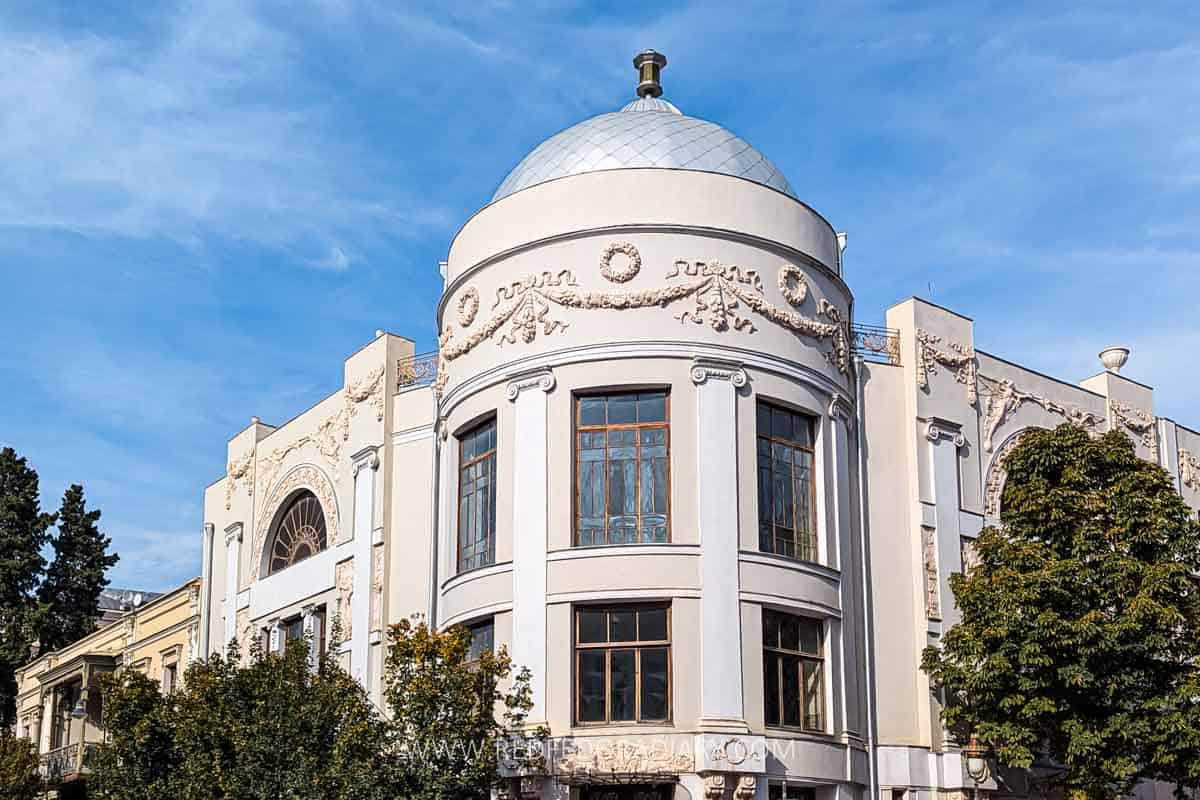
The area has some great eateries (some included in my restaurant guide), coffee shops, and even more authentic Tbilisi courtyards. The best way is to stroll around, detour between places, and get lost as you might stumble upon great finds.
Venture out to the Barakholka vintage market
Also known as Navtlighi Flea Market, Barakholka is a low-key alternative to the famous Dry Bridge market. Its name comes from the Russian word ‘Barakhlo,’ meaning old, unused items.

I have been gatekeeping it for quite some time because I didn’t want it to become as touristy as the other market. However, the word is out, and the prices consequently increased slightly.
Nevertheless, it is still a great vintage market in Tbilisi to rummage through all sorts of things, from old toys to pans and pots, old antiques and vintage furniture, utensils and sewing machines, pre-loved clothes to clay vases, and massive wooden chests.
Go inside the most lavish house in Tbilisi
The Writers’ House of Georgia is one of the most exquisite sites in Tbilisi’s historic Sololaki neighborhood, built by a German architect in 1905.


Originally, it was a manor of David Sarajishvili – a chemist, philanthropist, and the pioneer who introduced brandy-making to the Caucasus after studying cognac production in France and founding the first brandy factory in the region, a legacy still alive today under his surname sold in all the grocery and alcoholic shops nationwide.
Today, the Writers’ House is a complex consisting of a museum, a boutique hotel called Writer’s Residence, and seasonal dining restaurant Cafe Littera tucked away in its courtyard.
Inside, the building is a masterpiece of design, with wood dominating its elegant decor. My personal favorites? The breathtaking ceiling in the ground-floor living and dining room and the grand wooden staircase adorned with a stained-glass window.


Upstairs are the museum rooms, which delve into Sarajishvili’s life and legacy and showcase his beautiful memorabilia and the Museum of Repressed Writers. Refer to my museum guide for more details.
Before you leave, take a moment to admire the courtyard’s intricate mosaic terrace floor, custom-made by the Villeroy & Boch company. If Littera is open, grab a coffee and soak up the peaceful atmosphere. Whatever you do, don’t skip the bathroom on the ground floor to see a unique green sink with a fish-shaped faucet—easily one of the most extraordinary sinks I’ve ever seen!
Find the trace of abandoned Armenian churches
Much like German heritage, we have a long Armenian legacy in Tbilisi. Many were forced to move here in the late 18th century. During the Russian Empire, Tbilisi was the capital of the Caucasus, and the city was a melting pot for various nationalities. Armenian and Azerbaijani populations still live in Tbilisi. Avlabari, for instance, was known as the Armenian district for several decades.


Many wealthy merchants and businessmen of Armenian descent contributed to the city’s social and economic development, building beautiful houses and financing the construction of hospitals, institutions, and the basic infrastructure the city needed to develop.
With the growing Armenian population, their places of worship also grew, and Tbilisi had over 25 Armenian churches. Sadly, almost all had been destroyed, locked up, turned into Georgian Orthodox Churches, repurposed as residential, left to decay, and lost to time. Only two remain active today – Ejmiatsin Armenian Church next to Avlabari metro and St. George Cathedral of Tbilisi in the Old Town.
One of the quirky things to see in Tbilisi is the remnant bell tower of Vank Monastery, hidden off Baratashvili Street, a short walk from Freedom/Liberty Square.

Vank Monastery, also known as Pashavank, was constructed in the 14th century in a very unique design. The territory had a high-walled enclosure and solid brickwork exterior. The monastery had a triple-nave basilica plan and three cupolas, making it stunning and remarkable. It served as the seat of the Armenian archbishop.
The notorious Lavrenti Beria, Stalin’s right hand in many aspects, ordered the monastery’s demolishment in 1938. The unusual-looking bell tower, which is now part of the residential buildings, stays untouched, a remnant of history.
Another one that strikes me the most is the Church of the Red Gospel, also known as Karmir Avetaran Church or Shamkoretsots Sourb Astvatsatsin Church, in Avlabari, a short walk from the metro station.


This 18th-century Armenian church, standing in disrepair, must have been a gorgeous structure back in the day, judged by simply looking at its alter and ruins. At 40 meters in height, it was the tallest Armenian church that was demolished in 1989.
Locate the most beautiful wooden spiral staircase
Tucked away from the main streets behind Rustaveli metro in the courtyard, this one-of-a-kind wooden spiral staircase dates back to the 19th century, probably to the late 1890s, making it one of the last remaining of its kind. It has even been featured in the 1959 classic Georgian movie The Last Day, The First Day.

For many decades, this historical landmark was in a state of disrepair and on the verge of collapse due to financial limitations and the intricate nature of its construction.
With the support of The Heinrich Böll Foundation, Goethe Institute, Institut Français, Izolyatsia, i-Portunus, and the generosity of individual donors, a volunteer team of local and international architects created Kibe Projekt and worked hard for several months to restore this unique and the only remaining staircase of its kind.
Please Note: When visiting residential areas and courtyards, please respect their privacy, don’t be loud, and don’t wander through their living quarters.
Stumble upon the ancient wine cellar
Located at the corner of Melikishvili and Petriashvili streets, Wine Factory N1 is a historical landmark built by the Russian architect Aleksander Ozerov between 1894 and 1896.
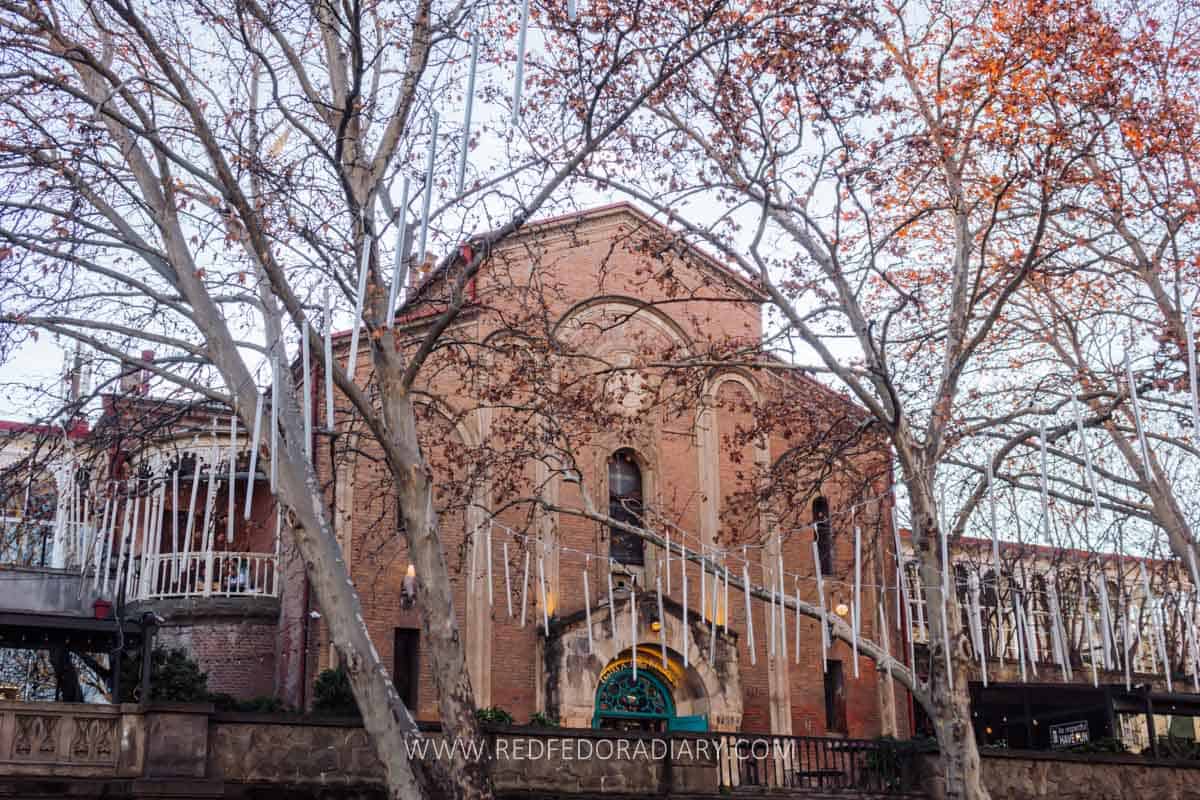
It is a unique construction using Georgian architectural forms and ornamental motifs of medieval church style. It looks like a basilica with decorative arches defined by shafts on the facade facing Melikishvili Street, window sills, and cornices. Reopened in 2018 as a complex of restaurants, cafes, and bars, Wine Factory N1 is a go-to place for many locals and expats to dine out or pre-party.
I am still looking for more information about the history of the former factory, but what I love the most is its preserved wine cellar, where you can peek through a glass and see massive shelves of bottles. Unfortunately, it’s not open to the public to go inside.

The one cellar is now part of the Sadzvele Wine Bar once you walk up the stairs through the flower shop at the corner of Petriashvili and Melikishvili streets and walk straight towards the main brick building. Unfortunately, you can only peek inside through a glassed door.
Spend weekends at lakes and parks
If you ask locals, they’d say Tbilisi needs bigger recreational areas and green spaces. There are small or medium-sized parks you can relax, but that’s not enough for us. Most of these parks feature benches and pavement paths, and walking in the grass-covered zones is prohibited in some.

When days get warm in spring and summer, locals flock to the parks and lakes surrounding Tbilisi. We love to lay our blankets, have picnics, and unwind.
My favorite parks are Deda Ena and Mziuri, which are easier to reach. Kus Tba (Turtle Lake) and Lisi lakes are other favorites for many, but you need to take a cable car (see my public transport guide to know how) from Vake Park to reach Kus Tba or a taxi to get to Lisi Lake.
Buy Georgian loose-leaf tea
Even though this tea shop is in the city center, a 3-minute walk from Freedom/Liberty Square, many visitors miss it. The Bitadze Tea Shop is also a tiny museum and one of my favorites.

It’s a great place to buy artisanal local loose-leaf tea and learn about the turbulent history of Georgian tea production. It sells tea from over ten tea growers of the Georgian Organic Tea Producers Association, the Bitadze family founded in 2006 to help revive tea production in Georgia.
This tiny venue also displays Georgian tea culture and history, from the tea production in Imperial Russia in 1847 to its peak in the Soviet era and a severe drop after the collapse of the Soviet regime.
Admire various archival photos, vintage tea boxes, and labels. The staff is friendly and happy to tell you about our rich tea history.
Visit the newly opened Radio City
A new multipurpose space by Adjara Group, similar to Fabrika but more grand, has partly opened in Tbilisi’s Gldani-Mukhiani district, a 10-minute bus ride from Akhmeteli metro station or a 30-minute car ride from the city center.
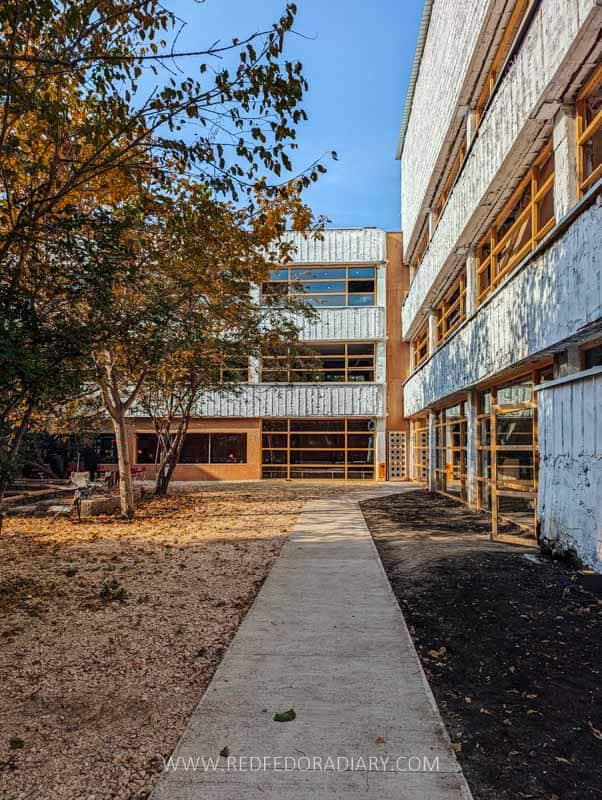
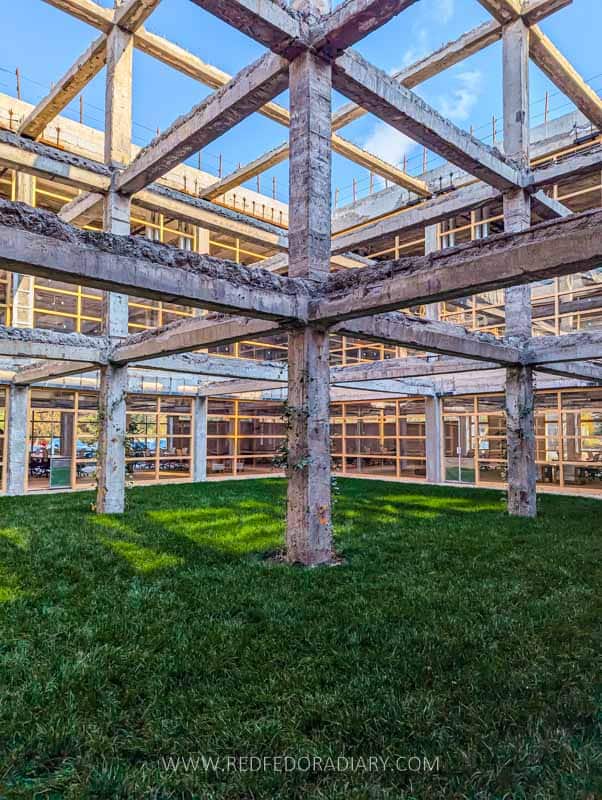
As with any enterprise of the Adjara Group, this is another repurposed area of the former radio factory encompassing three large buildings and 12 hectares of land, making it the group’s largest project.
Most of the spaces are still under construction. D Block will open another massive coworking space by the end of March 2025, followed by studios, workshops, and offices of local and international companies and entrepreneurs working in more than ten industries and 35 sectors. The project is planned to be finished by the end of 2025.
Currently, a diner, an office space that has already been rented out, conference and concert halls, recreational space, and a padel tennis courts are operating.

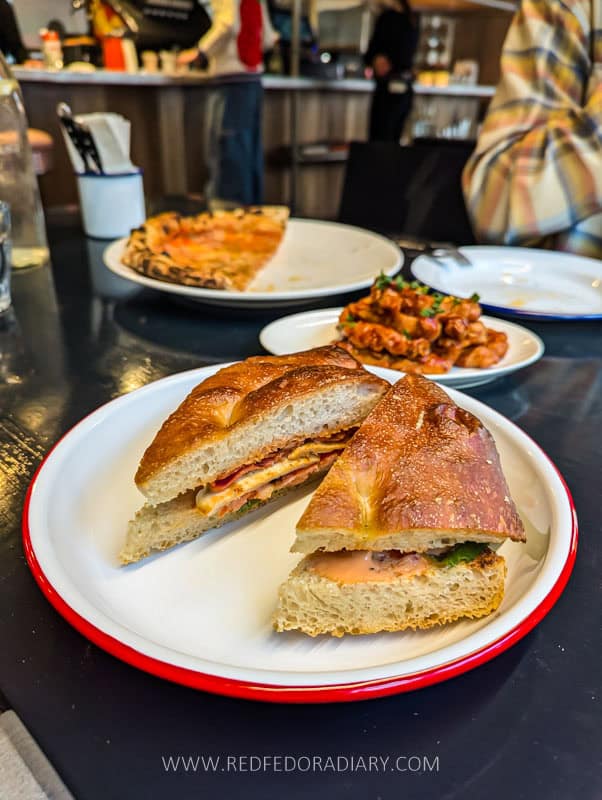
Its diner is designed in the style of American diners but with modern composition and furniture, yet the touch of vintage-style bar stools is spot on! The one-page food menu has several diner-style meals such as sandwiches, burgers, mac & cheese, onion rings, and chicken strips, along with Khachapuri, pizza, salads, and soups. They also offer an all-day breakfast of egg-based dishes, waffles, and pancakes.
Food is as good as in their other eateries, with most ingredients sourced from their Udabno regenerative farm. The prices are surprisingly low, even with 18 VAT added to the final bill. And if it stays this way, Radio City will become THE spot!
Things to do in Tbilisi for foodies
Devour in Georgian cuisine
I might sound biased, but Georgian food is one of the best cuisines with influences from the Middle East, Europe, and Asia, but having its own twist to the dishes.
The cuisine is as diverse as the country’s landscape, offering regional specialties and plenty of vegetarian options. However, it can be a bit heavy for many foreigners not used to dishes with so much dough, walnuts, spices, and herbs, but it’s heavenly delicious.

Khinkali (dumplings) and Khachapuri (cheese pie) are the staples of our cuisine and a go-to meals for every local (although I am a Lobiani, black bean pie, person), along with simple Georgian salad of tomatoes, cucumber, and walnut paste. Read my deep dive into Georgian foods you should try here.
Food is essential for Georgians; no gathering goes without a Supra, big or small. Therefore, the food scene in Tbilisi is really good, providing cheap bites, traditional restaurants, and fine dining. Check out my curated list of the best restaurants for Georgian cuisine and the ultimate guide on where to eat the best Khinkali.
Make Georgian food yourself at the cooking class
Cooking classes offer a unique, hands-on opportunity to explore local cuisine while diving into the culture and history of the destination. Depending on your schedule and interest, Tbilisi has a few options. For a more immersive experience, spend a few hours cooking multiple dishes and sharing your creations with your hosts.
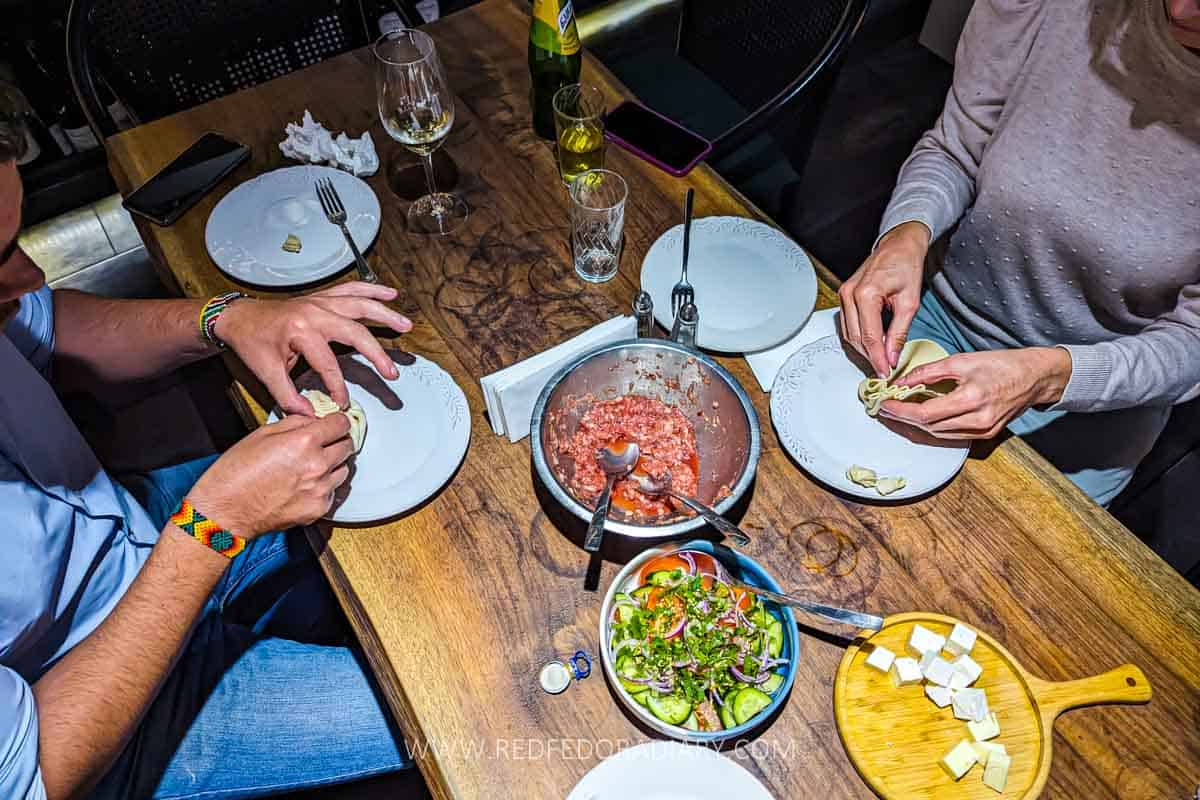
Alternatively, opt for a shorter class focusing on Georgian classics like Khinkali and Khachapuri, where you’ll spend an hour or two learning to prepare these iconic dishes before savoring them.
Recommended cooking classes in Tbilisi:
Drink Georgian wine
Like the sulfur baths, no visit to Georgia is complete without trying local wine. Did you know we are the oldest winemaking country in the world? Yes, you read it right!

In 2017, archaeological discoveries in the Kvemo Kartli region, just 50 kilometers south of Tbilisi, revealed chemical evidence of wine production dating back to 6000–5800 BC during the early Neolithic period. We have always said that Georgia has at least 8,000 years of winemaking heritage, and it’s scientifically proven! Moreover, Georgian winemaking traditions have been included in UNESCO’s list of Intangible Cultural Heritage since 2013.
The traditional Georgian winemaking method includes fermenting crushed grapes with their stems and skin in giant, egg-shaped clay jars called qvevri, buried underground in a cool cellar. The process takes at least 6 months, but some winemakers keep the wine in qvevri longer or take it out sooner. Some wineries also make it in steel tanks using the so-called “European style,” without stems and less skin contact.


Due to the favorable climate with many warm sunny days and diverse soil, Georgia boasts over 500 grape varieties. Sadly, during the Soviet era, many vineyards growing unique and exotic grape varietals were replaced with a focus on a limited selection, prioritizing quantity over quality and diversity. This shift drastically impacted Georgia’s winemaking traditions, but we kept the ancient methods and its unique flavors.
Qvevri wines are bold with earthy flavors and tannins, which need some getting-used-to for those unfamiliar with such wines. Traditional white wines are of amber color of all shades from light to dark, whether aged in qvevri or the steel tank. Reds are full-bodied and quite dark-colored, so we call them “black wine” in Georgian instead of red.


Similar to food, wine also plays a big part in Georgians’ lives. Almost every family, including mine, makes its own wine at home for consumption. We even have the saying: “One glass of red wine a day keeps the doctor away.“
Winemaking happens every autumn when Georgia has the Rtveli wine harvest, which you can participate in. It’s a fun event where you actually roll up your sleeves and dive into the entire process, from picking up the grapes, crushing, putting in the vessel, and finally rewarding yourself with a big Supra feast.
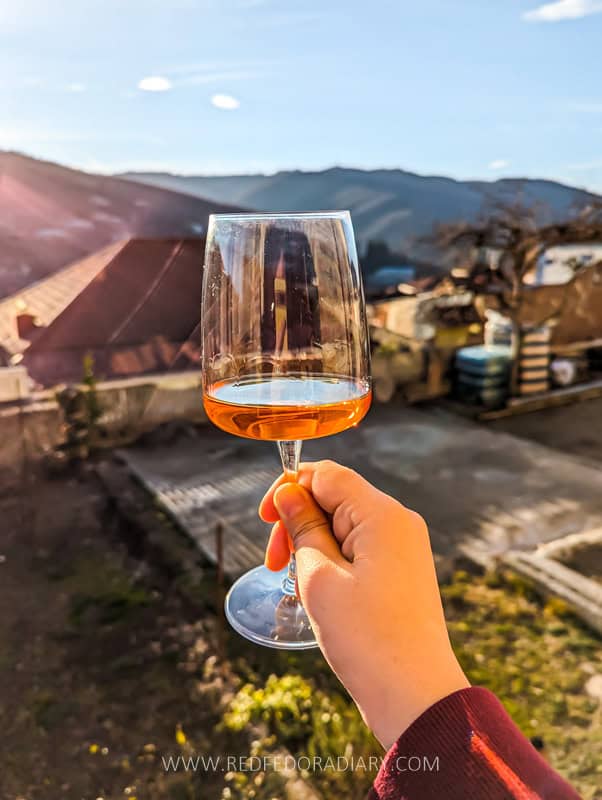

Among Georgia’s standout grape varieties, Saperavi reigns as the most popular red, while Rkatsiteli leads the whites. Kisi and Khikhvi are amber wines with a beautifully complex profile.
Trying Georgian wine is the most effortless activity on this list. There are several dozen wine bars in Tbilisi selling it by glass. But if you want to learn more about the process and try 3-5 types, a few offer wine tasting packages with a small plate of snacks. My favorite with a professional sommelier is any branch of 8,000 Vintages wine shop and bar.
And if you decide to do a wine tour in Kakheti, the prime wine country, read my tips on how to choose the best wine tour.
Rtveli harvest note: My friends and partners at Eat This! Tours offering small group authentic premium tours have a variety of harvest and classic wine tour options to choose from. Remember to use code RFD5 at checkout for a 5% discount. If you want to know what to expect, read my review of their Sighnaghi Wine Tour. Alternatively, check out WT Georgia, which also offers wine harvest tours nearby at a local family.
Do a shot of Chacha
The winemaking process also leaves some leftovers, the fermented grape residue of skins, seeds, and stems we call chacha, that we use to distill it into a highly alcoholic spirit, also called Chacha, beloved by Georgians but slightly despised by foreigners mainly because of its strength and a high percentage of alcohol (can be up to 70%).
Like wine, Chacha plays a significant role at cultural and social events and is sometimes integral to casual gatherings and Supras. And much like wine, Chacha varies in flavors and aromas. We also make it from various fruits besides grape leftovers, such as quince, feijoa, persimmon, figs, etc.
However, note that not all Chacha is equal, especially the homemade ones! Drink with caution, as it can have a pretty bad hangover. You won’t have a problem finding it at restaurants or bars, but for a slightly different experience where you can learn more about the drink and have a chance to try some, visit the Chacha Corner shop, a few minutes from Freedom/Liberty Square.
Get bread from the bakery
The most “dangerous” thing in Georgia is the bread, or puri in Georgian, baked in a vertical clay oven called tone (think of a tandoor), ideally over a wood fire. When fresh out of the oven, it’s an addictive food you can finish without even realizing!

The bread is called either Tone or Shoti; there is no much of a difference between them, it’s how people in different areas are used to call it. Tone and Shoti breads come in difference is shape – round, half-moon, or boat-shaped. Kakhuri Shoti is much crispier. Both are very good; it’s just a matter of personal preference and which is available at the bakery.
The bread goes with everything, but it’s incredibly delicious with sulguni Georgian cheese (think of a salty mozzarella), cucumber and tomatoes, or Guda goat cheese.
You can find the Tone bakeries in every neighborhood of Tbilisi, sometimes even several in one area. They mainly have Georgian signage თონე, but the smell of freshly baked ones is so intense that it will lead you to the spot. Most Georgian restaurants have it on their menus, too.
The most popular tone bakery in the old town, right behind the Tamada Statue, has been closed since the COVID pandemic and turned into the usual bakery.
Eat Ponchiki
Ponchiki is a sweet pastry with cream inside that is a popular dessert or snack in Russia and some post-Soviet countries. There are several varieties of ponchiki out there, but the Georgian version is a big round but flat-ish, deep-fried doughnut with vanilla cream inside and topped with powdered sugar.

The best place to try one is at Puri Guliani restaurants, either near the Dry Bridge or at Mtatsminda Park. The latter is the place where I typically eat it because of childhood nostalgia.
Snack on Churchkhela
When walking around Tbilisi Old Town, you’ll notice stalls selling weird-looking colorful items hanging on a string, like candles or sausages.That’s Churchkhela, another addictive snack made of walnuts or hazelnuts traditionally dipped in grape juice. There are other variations, too.


The texture is like a stiff jelly and has an acidic taste but is typically pretty sweet. Churchkhela is high in calories and can be stored very long. Because of these characteristics, it was a go-to snack for the army back in the day and remains a national favorite.
We make Churchkhela at home as a preparation for Christmas and New Year, but if I need to buy some outside this festive season, I usually do it at the Badagi shop or stands it has at various supermarkets across the town.
Sample Laghidze lemonade
This is another one of my childhood favorites and a ‘nostalgia’ item. Even though it doesn’t taste as good as I remember, I still don’t pass up the opportunity to have a glass or two when I see them on the menus. Laghidze Water, founded by Mitrophane Laghidze, a pharmacist from Kutaisi, was a very popular Georgian soft drink back in the day.

In 1887, he worked on the idea of creating natural syrups and using them in lemonades instead of imported flavored essences. In 1900, he built a factory in Kutaisi and started producing syrups made from herbs and fruits. Six years later, in 1906, with the help of several philanthropists, he opened the very first shop in Tbilisi.
Traditionally, the Laghidze lemonade is made by mixing the syrup with a soda from the fountain right in the glass and in front of you. The flavors were very diverse, but the most popular among Georgians were pear, tarragon, citrus, vanilla, and chocolate.
The popularity of Laghidze lemonade grew all over the country, so much so that the Soviet government commercialized and expanded it even further. Besides being available in their venues, the lemonade was bottled and exported within the USRR. It was such a big deal that the government even presented it at the historic conferences of 1943 held in Tegeran and then in 1945 in Yalta.

I remember going to one of their venues on Rustaveli Avenue as a kid, either before or after my English language classes, but unfortunately, they all closed down over the years.
Today, several cafes and restaurants have traditional syrup-soda-mixture lemonades on their menus. I typically order a vanilla-chocolate mixture at Cafe Stamba or Puri Guliani. There’s also a stand at Bazari Orbeliani food court, but I prefer other places.
However, after talking to a few foreign friends, it’s their least favorite drink as it looks and tastes strange and is sweeter than they’d prefer. But try it and see for yourself.
Cozy up at cafes for coffee, breakfast, and cake
The cafe scene in Tbilisi offers a plethora of choices. Whether you are looking for a specialty coffee spot or a place to get a hearty Georgian and European-style breakfast or want to take a break and cozy up at its modern or vintage manner cafes, I am sure you’ll find something that suites your taste and needs.
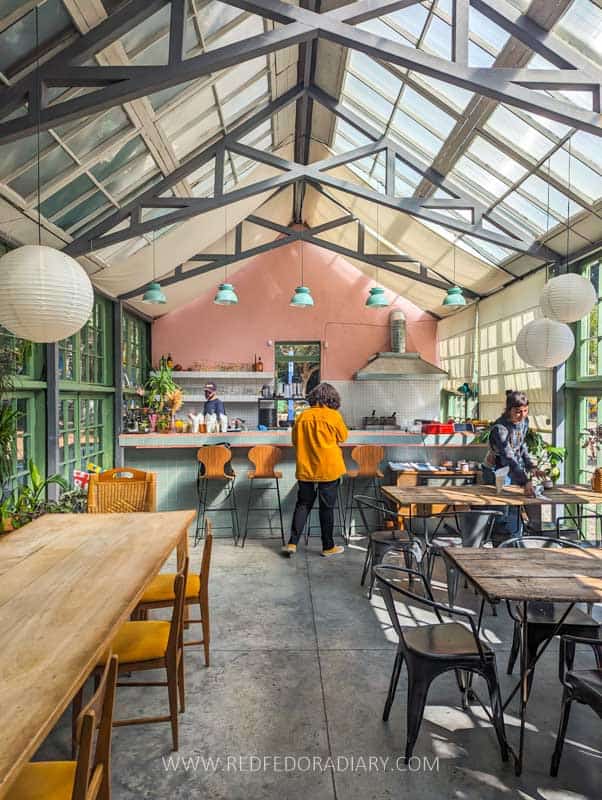

There is no special district for the best cafes in Tbilisi, as they are all over the city. So check out the posts I have linked above and find your choice, or be spontaneous and walk into the one you find during your wanderings.
Soviet things to do in Tbilisi
Tbilisi’s complex history is entangled with layers of Soviet influence, leaving behind a unique architectural and cultural legacy. From monumental brutalist architecture to socialist mosaics and relics of a bygone era, the city offers an intriguing journey through its Soviet past.
Many of them are a bit away from the center, except for the ones on Rustvaeli Ave, so you need to use public transport to reach them, but it’s often worth adding them to your Tbilisi itinerary.
Go down the first legal Soviet Bunker
Did you know Tbilisi is said to have around 450 Soviet-era bunkers hidden beneath its streets? Mind-blowing, right?! While most of these bunkers are abandoned, sealed off, or unsafe to explore, there’s one you can visit safely with a guide – Tornike, an urbex expert.


If you’re into quirky adventures, Soviet nuclear bunkers, or a touch of dark tourism, this tour is right up your alley! Read my dedicated post to learn more about the “bunker rush” during Soviet times and what to expect on this unique underground journey.
Tour Tbilisi metro stations
Constructed pretty deep underground to be used as a shelter in case of an emergency and attack, visiting the Soviet metro system is an experience on its own if you haven’t been in such before.
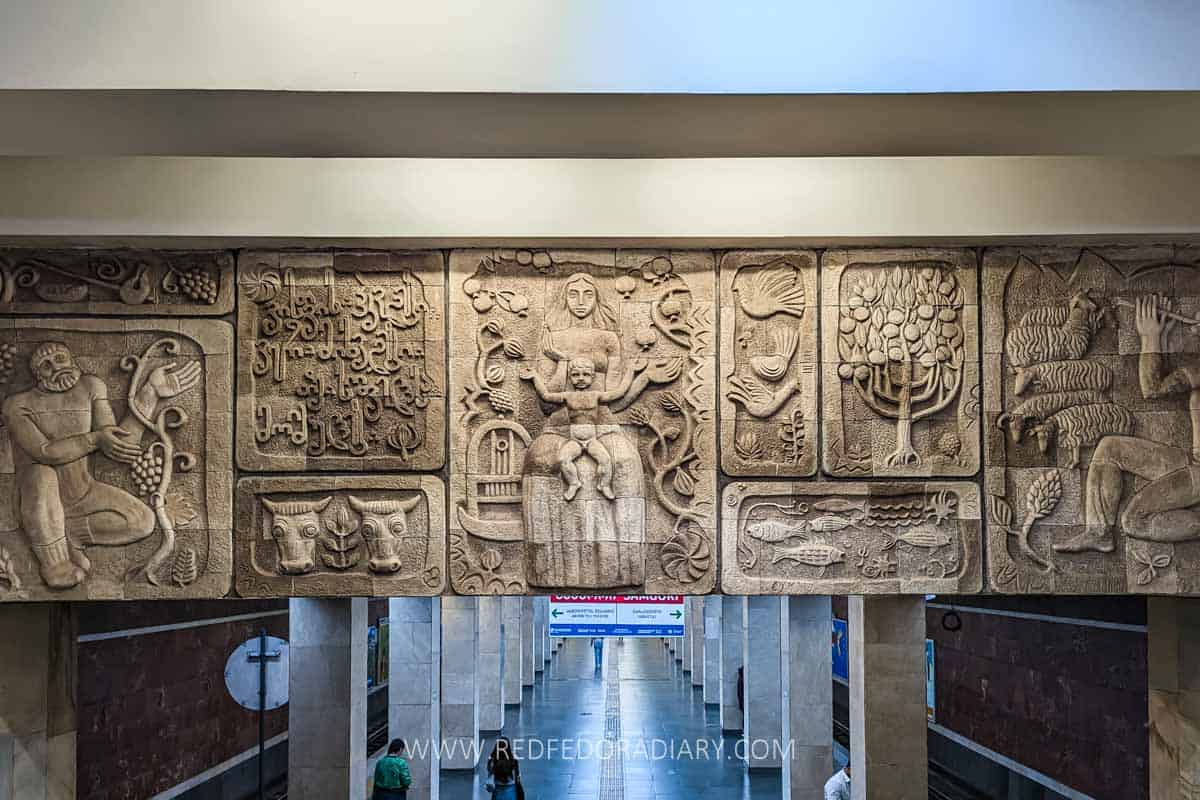
Tbilisi metro, opened in 1966, was the fourth metro system in the ex-Soviet Union. Currently, it has only two lines and 23 stations. Like any other USSR metro system, ours is deep (the deepest being Rustaveli) and has fast escalators.
The trains are frequent and speedy, but quite loud, so much so that talking or listening to something without noise cancelation headphones is nearly impossible. Because trains move fast and sudden speed up or slow down is standard, ensure you hold onto the handrail when standing.
While the stations might not be as grand and lavish with their decorations as those of Tashkent, Uzbekistan, Kharkiv, Ukraine, or Moscow, Russia, we do have a few beautiful stations. It’s worth mentioning that almost every station has some decoration, big or small, and their beauty is in the details rather than a broad look.


The most beautiful and worth visiting is the Technical University station on the second (Saburtalo) line, featuring gorgeous mosaic decoration on both sides of the exit/entrance. Grmaghele station on the first line (Varketili-Akhmeteli) has high-relief images honoring metro builders and the industry.
Samgori, also on the first line, has charming bas-relief entrances with folk motifs at the top of the stairs on both entrance/exit sides. The platform also has several verticle rectangular-shaped black iron relief decorations. Rustaveli has a bas-relief at the entrance to the metro, honoring Shota Rustaveli, the medieval poet, with the phrases and lines from his epic The Knight in the Panther’s Skin.
Interesting fact: In the ex-Soviet Union, Tbilisi was one of the few cities where work on the metro design began before the population reached one million. Usually, the USSR required a population of over one million in the city to build a metro plan.
Track down Soviet architecture
Georgia is among those countries still preserving a good amount of Soviet architecture and memorabilia, and Tbilisi is no exception. Except for several centrally located buildings, most striking Soviet architectural examples are spread out, requiring planning and the use of public transport.


I have a few absolute favorites, such as Palace of Rituals (also known as Wedding Palace), today’s Biltmore Hotel, the famous Chronicles of Georgia (more below), the current Bank of Georgia Headquarters that looks like Tetris figures, and abandoned Museum of Archeology.
I have created a #RFDSoviet tag for my socials (Facebook and Instagram) to share various Soviet relics across Georgia, buildings, their stories, and other details.
Ride renovated cable cars
Another fun thing to do in Tbilisi is to ride the renovated cable cars. The recently opened Rustaveli-Mtatsminda Park cable car has modern gondolas, while the lower station is another excellent example of Soviet architecture.

For an adrenaline rush, try the Vake Park-Kus Tba cable car, which still operates with a Soviet-era-looking cart. The Bagebi-Maglivi State University Building has a more substantial carriage that accommodates up to 40 people (!). Remember to check my transport guide for details on how to use the cable cars in Tbilisi.
Head out to the Chronicles of Georgia
Because of its location far away from the city center, tourists or locals rarely visit the Chronicles of Georgia. However, its inclusion in many travel blogs makes this unique landmark a popular but not overcrowded place.


Also dubbed “Georgia’s Stonehenge,” the monument perched on top of the hill overlooking Tbilisi and Gldani-Mukhiani districts is a creation of the famous Georgian sculpture Zurab Tsereteli in 1985. It includes 30-meter-tall 16 pillars that showcase statues of Georgian kings and queens, heroes, legends, and scenes from the life of Jesus.
Prominent figures like King Tamar (Georgia’s most notorious female leader) and David Aghmashenebeli (David the Builder in English) are in central positions. And even though the monument looks finished, it is not.
I recommend ordering a Bolt taxi to get there easily from the city center. You could also use public transport via Google Maps navigation from your location, but it would be time-consuming.
Visit Stalin’s Secret Publishing House
You might already know that Stalin was Georgian, born in Gori, and lived some time in Tbilisi. He even studied at Tbilisi Theological Seminary until he was kicked out.
In the early years of his involvement in the Bolshevik movement, he oversaw the printing and distribution of propaganda materials, conveying the message of overthrowing the Tzsar through an illegal printing house laid out underneath a nondescript residential building in the Avlabari neighborhood.
Stalin’s Secret Printing House had the status of a museum, but around a decade or more ago, the authorities unlisted it and cut off the funding. The place is crumbling and in terrible condition, but it is the weirdest thing to do in the city. It is open to the public for free, but I recommend donating a few GELs to the caretaker when you visit.
You can see various printed magazines, pamphlets, and newspapers, where the printing press was located, how they concealed it, and even see a room Stalin would overnight.
Feast your eyes on beautiful Soviet mosaics
Soviets loved decorating buildings, bus stops, and fountains with mosaics that often carried propaganda messages and utopian socialist reality. These mosaics are gorgeous and a great form of art in their own way. They fascinate me so much that I search for them everywhere I travel across Georgia.


The most impressive mosaics are at Expo Georgia.The fire department building near Ortachala bus station and on Saburtalo’s Bakhtrioni Street are all quite thematic. Next to the Delisi Metro, the Trade Union Cultural Center building has some of the best-preserved mosaic decorations, as does the former Metro Samgori railway depot.
Things to do in Tbilisi at night
As the sun sets, Tbilisi transforms into a bustling city brimming with energy. Tbilisi nightlife offers a variety of choices, be it a night out at the bars, attending a cultural event, or having a laid-back stroll along the illuminated city. Whether you want to dance the night away, sip cocktails, or soak in the atmosphere, this section lists some of the best things to do in Tbilisi at night.
Start the evening at various bars
Kicking off an evening in Tbilisi means diving straight into its vibrant bar scene. The city has endless choices, with each venue offering something distinct, be it quirky and vintage interiors, craft cocktails, or a cozy atmosphere at sophisticated establishments.


The city center is a great area to start the evening, with plenty of wine bars, craft beer places, and cocktail venues. Locals don’t typically go to places in the Old Town but head to the Sololaki district, around Rustaveli Ave, and a bit beyond the center. Check out my Tbilisi bars guide for some inspiration.
Watch some performance
If you are looking for cultural immersion, your best options are theater, concerts, and the Opera. Only a handful of theaters offer English subtitles, but you can still enjoy unique experiences like the adult puppet shows at the Gabriadze Theater.
For something grander, consider a ballet or opera performance at the stunning State Opera House on Rustaveli Ave. Another must-see is the Sukhishvili Georgian National Ballet. Their top-rated shows often sell out quickly, so secure your tickets as early as possible.
Tbilisi hosts a variety of concerts, live performances, and other events throughout the year, so there’s always something exciting to discover. I recommend checking out Tkt.ge or Biletebi.ge to browse upcoming options and book tickets.
Enjoy the Georgian dance show at the restaurants
Where to see Georgian dances? I get asked this quite often. While I highly recommend attending a show of traditional Georgian dances in a concert hall, a few restaurants offer shorter versions if you can’t.
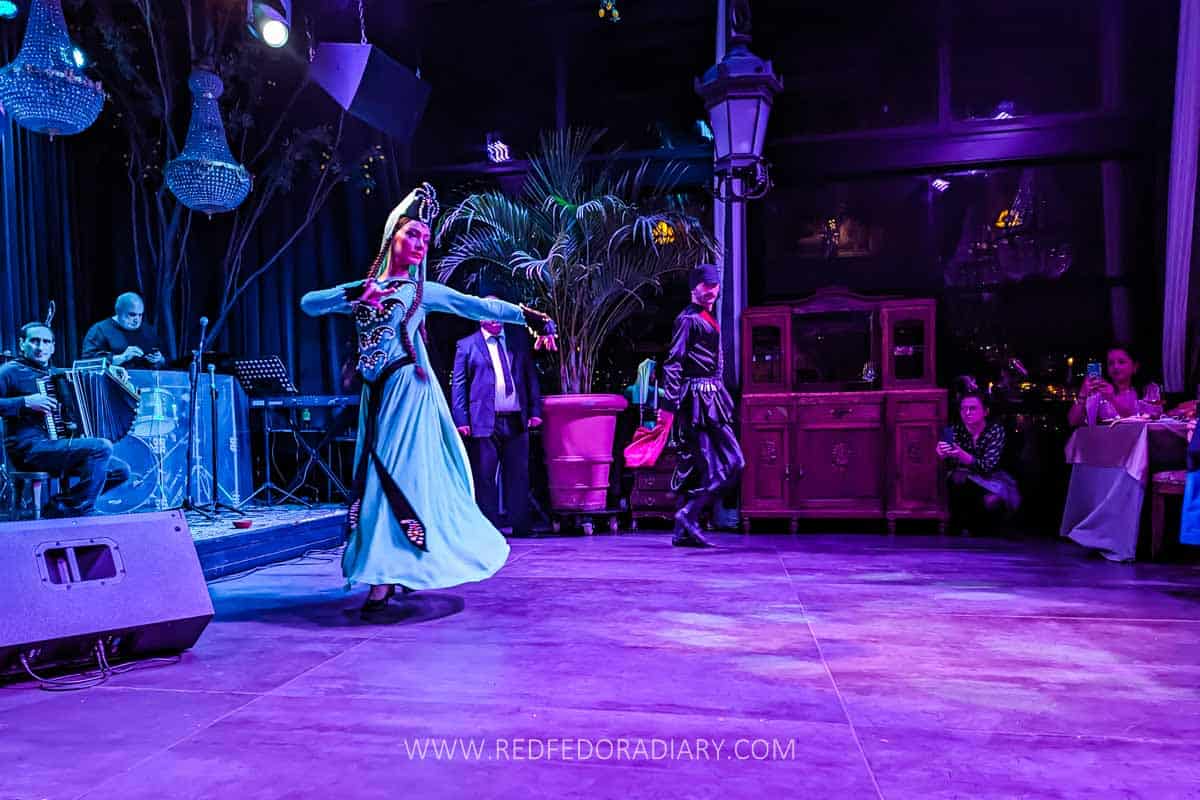
Tsiskvili and Ethnographer are popular choices for many, serving delicious food. The only drawback is that they are both far from the city center and with the rush hour traffic, it can take time to get there. For a closer alternative, check out In the Shadow of Metekhi, a 15-minute walk from Avlabari metro station.
Dance till the down
I’m not typically a club person, but I enjoy late-night outings occasionally. For those here to experience Tbilisi nightlife to the fullest, the epic Bassiani club, housed in a repurposed Soviet-era swimming pool underneath Dynamo Stadium, should be on the list.
Dubbed “the Georgian Berghain,” but with a less strict door policy, Bassiani is about more than just the beats—it’s about the atmosphere. The crowd is inclusive and nonjudgmental, the energy is electric, and the focus is purely on the music.
To party at Bassiani, you need to get verified first on their website via your social profiles, so plan ahead and don’t show up at the door. Other great clubs are TES, Left Bank, and Mtkvarze.
Go beyond Tbilisi: hikes and day trips to take
Depending on your trip time, Tbilisi is a great base to do some day trips nearby or even spend time hiking in nature within the city limits!
The former capital Mtskheta, Stalin’s birthplace of Gori, and Uplitsikhe cave town are popular day trips from Tbilisi, along with a Stepantsminda with its beautiful Gergeti Trinity Church under the foot of Mount Kazbegi and Kakheti wine region’s Telavi or Sighnaghi.
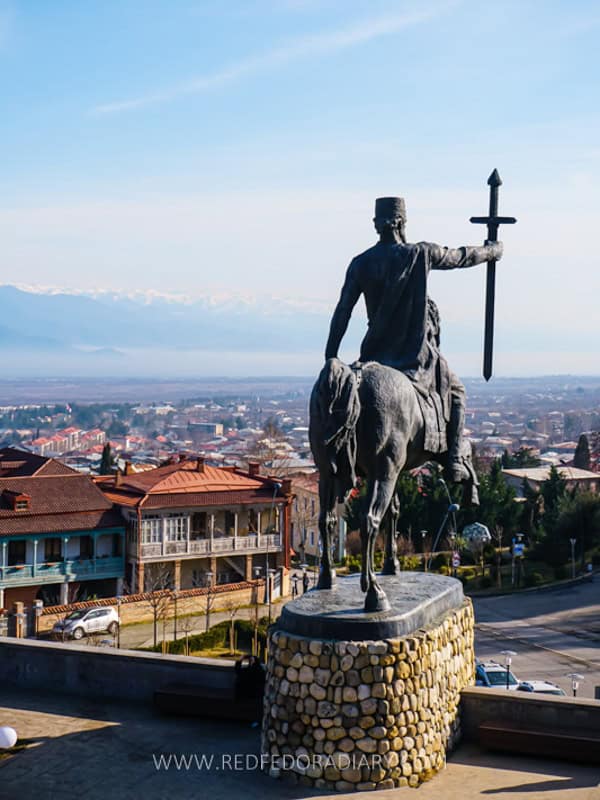

Nature enthusiasts can hike from Tbilisi’s Korjori townlet to Asureti, a former German settlement, or go on a short hike in Birtvisi and Tsalka (Dashbashi) canyons, the latter known for the giant glass diamond shape bridge.
You can use public transport, join a group tour, or rent a car. Alternatively, you can hire a driver via GoTrip for reasonable prices. I use them occasionally, and they are always reliable. GetYourGuide or Viator has plenty of organized tours to the most typical destinations near Tbilisi.

If you are up for a wine tour that includes a bit of sightseeing and other cultural experiences within a smaller group, plenty of food, and almost unlimited wine, check out Eat This! Tours packages for Sighnaghi and Telavi. I’ve been on their Sighnaghi tour and absolutely loved it. You can read my review here. Remember to use code RFD5 at checkout for 5% off.
For fun advantages and outings in nature, either within the city borders or a bit further away, check WT Georgia, which offers unique experiences for smaller groups.

We have a friend who have always invited us to visit the Tiblisi and now thank to your post we know why. With your photos you inspired us and we’d love to try your same experience especially the visit at the epicenter of Georgian history!
I have to admit I have never even thought of visiting Tbilisi, but you make it sound well worth a visit! And the food looks delicious as well!
This is great. I had no idea that there was so much to do there. I love wandering through old town areas, so this looks like it would be a great place for me to visit. I’d especially love to hang out on the “sea” too.
I’m a HUGE HP fan, so the Public School N6, mini-hogwarts-lookalike does it for me! These all look like so much fun! Definitely pinning your post for later 🙂
With flights now so easy to get with WizzAir from London, I am now looking at visiting Tblisi and go hiking in the mountains. I have always wanted to go here as the scenery looks stunning. 🙂
Oh my goodness, This is lovely! I’m sorry to say, I hadn’t ever thought of visiting Tbilisi, but the streets of old town, Narikala Fortress, the puppet show at tower clock – these look wonderful! Thanks for showing me your hometown. <3
I would love to visit Tbilisi! It looks like an absolutely gorgeous town. How is the language barrier? Is it a fairly affordable place to visit? I love your tip about museums. I’m not much of a museum fan either, but its good to know that they may actually be worth a visit!
Most of the people speak English in Tbilisi, however if you travel to remote parts of the country you’ll experience the language barrier. And yes, it’s quite budget-friendly
Reading through the post I kept wondering: where is the food? And the wine? I visited your beautiful country a few years ago but I explored the east and didn’t make it as far as Tbilisi, but I was absolutely mesmerised by the food – which I was a huge fan of already, as it is quite popular in Poland, too, where I got to taste it for the first time. The wine is absolutely awesome, too. I am a big lover of dry red wine and those 4 days in Georgia I really spoiled myself. I really want to go back one day, Georgia made a big impression on me and made me feel incredibly welcome.
Wow, Georgia has been on my bucket list for quite a while, but you make Tbilisi look even more incredible! Great post and I will use your suggestions one day!
I’m hoping to go to Tbilisi next year and am definitely saving this guide. Great recommendations! 🙂 What’s typically the best season to visit?
Late spring or early Autumn. The summer is very hot in here. Temperature might go up to 40-45c in July and August
Wow, I would definitely put Tbilisi on my list. I had no idea is so amazing. Thanks for putting together such an awesome list of things to do 🙂
Tbilisi is on my travel list and those photos are calling out, definitely will try the sulfur bath, hike towards the falls and enjoy the geordian ?
We (me, husband) visited the Caucasus in 2016 and had such a good time we came home and set about organizing our return – this time bringing a group of 10 friends with us. Tbilisi was my absolute favourite place. We’ll be there in June – I am so looking for ward to it!
Hi Baia, I’ve read your blog with much interest as I’ll be in Tbilisi end of May / early June . I’m an (amateur) photographer with a huge interest for abandoned buildings. Is it true renovation started at the former museum of Archeology ? Is laguna Vere really inaccessible ? Other suggestions concerning abandoned buildings ? It was great reading your blog as we have several mutual places we’ve visited (Budapest , Prague , Croatian coast, Marrakech) ; great locations and for me reading your blog felt like a revisit .
Greetings Dominiek